No products in the cart.
Sailing Ellidah is supported by our readers. Buying through our links may earn us an affiliate commission at no extra cost to you.

The Running Rigging On A Sailboat Explained
The running rigging on a sailboat consists of all the lines used to hoist, lower, and control the sails and sailing equipment. These lines usually have different colors and patterns to easily identify their function and location on the vessel.
Looking at the spaghetti of lines with different colors and patterns might get your head spinning. But don’t worry, it is actually pretty simple. Each line on a sailboat has a function, and you’ll often find labels describing them in the cockpit and on the mast.
In this guide, I’ll walk you through the functions of every component of the running rigging. We’ll also look at the hardware we use to operate it and get up to speed on some of the terminology.
The difference between standing rigging and running rigging
Sometimes things can get confusing as some of our nautical terms are used for multiple items depending on the context. Let me clarify just briefly:
The rig or rigging on a sailboat is a common term for two parts, the standing , and the running rigging.
- The standing rigging consists of wires supporting the mast on a sailboat and reinforcing the spars from the force of the sails when sailing. Check out my guide on standing rigging here!
- The running rigging consists of the halyards, sheets, and lines we use to hoist, lower, operate and control the sails on a sailboat which we will explore in this guide.
The components of the running rigging
Knowing the running rigging is an essential part of sailing, whether you are sailing a cruising boat or crewing on a large yacht. Different types of sailing vessels have different amounts of running rigging.
For example, a sloop rig has fewer lines than a ketch, which has multiple masts and requires a separate halyard, outhaul, and sheet for its mizzen sail. Similarly, a cutter rig needs another halyard and extra sheets for its additional headsail.
You can dive deeper and read more about Sloop rigs, Ketch Rigs, Cutter rigs, and many others here .
Take a look at this sailboat rigging diagram:
Lines are a type of rope with a smooth surface that works well on winches found on sailboats. They come in various styles and sizes and have different stretch capabilities.
Dyneema and other synthetic fibers have ultra-high tensile strength and low stretch. These high-performance lines last a long time, and I highly recommend them as a cruiser using them for my halyards.
A halyard is a line used to raise and lower the sail. It runs from the head of the sail to the masthead through a block and continues down to the deck. Running the halyard back to the cockpit is common, but many prefer to leave it on the mast.
Fun fact: Old traditional sailboats sometimes used a stainless steel wire attached to the head of the sail instead of a line!
Jib, Genoa, and Staysail Halyards
The halyard for the headsail is run through a block in front of the masthead. If your boat has a staysail, it needs a separate halyard. These lines are primarily untouched on vessels with a furling system except when you pack the sail away or back up. Commonly referred to as the jib halyard.
Spinnaker Halyard
A spinnaker halyard is basically the same as the main halyard but used to hoist and lower the spinnaker, gennaker, or parasailor.
The spinnaker halyard is also excellent for climbing up the front of the mast, hoisting the dinghy on deck, lifting the outboard, and many other things.
A sheet is a line you use to control and trim a sail to the angle of the wind . The mainsheet controls the angle of the mainsail and is attached between the boom and the mainsheet traveler . The two headsail sheets are connected to the sail’s clew (lower aft corner) and run back to each side of the cockpit.
These are control lines used to adjust the angle and tension of the sail. It is also the line used to unfurl a headsail on a furling system. Depending on what sail you are referring to, this can be the Genoa sheet , the Jib sheet , the Gennaker sheet , etc.
The outhaul is a line attached to the clew of the mainsail and used to adjust the foot tension. It works runs from the mainsail clew to the end of the boom and back to the mast. In many cases, back to the cockpit. On a boat with in-mast furling , this is the line you use to pull the sail out of the mast.
Topping lift
The topping lift is a line attached to the boom’s end and runs through the masthead and down to the deck or cockpit. It lifts and holds the boom and functions well as a spare main halyard. Some types of sailboat rigging don’t use a topping lift for their boom but a boom vang instead. Others have both!
Topping lifts can also be used to lift other spars.
A downhaul is a line used to lower with and typically used to haul the mainsail down when reefing and lowering the spinnaker and whisker poles. The downhaul can also control the tack of an asymmetrical spinnaker, gennaker, or parasailor.
Tweaker and Barber Haul
A tweaker is a line, often elastic, attached to the sheet of a headsail and used to fine-tune the tension on the sheet.
Barber haul
A barber haul is a line attached to a headsail’s sheet to adjust the sheeting angle to the wind. It is often used to pull the clew further toward the center or outboard than the cars allow.
Boom Preventer
A boom preventer is a line attached to the boom’s end when sailing off the wind. Its function is to hold the spar in place and prevent it from swinging wildly.
If the boat were to get an accidental gybe, it could cause serious damage to the rigging or even harm people on board. It is important for the rigger to be cautious when setting up the boom preventer.
Running Backstay
Running backstays is similar to a normal backstay but uses a line instead of a hydraulic tensioner. Some rigs have additional check stays or runners as well.
Bonus tip: Reefing
The term reefing is used when reducing the effective sailing area exposed to the wind of a given sail. Headsails are usually reefed by partially furling them in, and they often have marks for what we refer to as 1st, 2nd, and 3rd reefs.
The mainsail is reefed similarly with an in-mast furling or in-boom furling system.
On a traditional mast, we use a system called slab reefing. The system has reefing lines running through the boom to reinforced points on the luff and leech, allowing you to pull the sail down to the boom and effectively reduce the sail area.
Having at least two reefing points in the mainsail is normal, but most cruising sailboats have 3. The 3rd is used for the heaviest conditions, giving you only a tiny bit of sail area exposed to the wind.
You want to reef your sails before the wind increases to a point where your boat gets overpowered.
It is essential to practice your reefing technique . You will find yourself in situations with rapidly increasing winds where you need to reduce your sails quickly.
Rule of thumb: If you think setting a reef might be a good idea, do it.
Shaking a reef is the term used when we sail with a reefed sail and want to increase the sail area back to full.
Hardware used for sail handling and the running rigging
Furling system.
Most sailboats have their headsail on a furling system. A furling system is a tube that runs along the forestay from the bottom furler drum to the masthead swivel.
This system allows you to roll the headsail around the forestay, making furling the sail in and out accessible. It is also convenient when reefing the sail when the wind picks up, as you can easily do this from the safety of the cockpit. These furling systems come in manual versions and electric versions.
In-mast furling
In-mast furling is a system that rolls the mainsail in and out of the mast. To unfurl the mainsail, we use the outhaul .
In-boom furling
In-boom furling is a system that rolls the mainsail in and out of the boom. This system has been costly and has mostly been seen on big yachts earlier. They are becoming more affordable and common on smaller boats, though. To unfurl this setup, we use the main halyard.
A Stack pack is also called a Lazy Bag or Lazy Pack. It is a bag with a zip attached to the boom where the mainsail is stored when unused. It protects the mainsail from UV rays from the sun and weather elements. It is a very nice and tidy way to store the mainsail and reefing lines if you don’t have in-mast or in-boom furling.
Lazy Jacks is a system of lines running from the stack pack to the mast. The Lazy Jacks guide the mainsail up and down from the Stack Pack and prevent it from falling down on the deck. It is also possible to rig Lazy Jacks without a Stack Pack.
A block is a pulley with a sheave wheel. Blocks are used to change the direction of a pull on a line or rope and give a mechanical advantage. They have many uses, especially onboard sailboats.
A winch is a metal drum that gives you a mechanical advantage to control and tighten lines. These can be operated by turning a rope around it and pulling manually or by a winch handle to get more force. Most modern winches are self-tailing, which means they lock the line on so you can winch the line without holding on to it. Some boats even have electrical winches operated by a button.
Mainsheet Traveler
The mainsheet traveler is a horizontal track that the mainsheet is attached to through a series of blocks. The traveler enables you to adjust and lock the boom at an angle and also plays a critical part in trimming the mainsail.
Most cruising sailboats have their traveler attached to the top of the coachroof in front of the spray hood. A racing boat typically has the traveler in the cockpit near the helm to give the helmsman better control over the mainsheet.
The cars are basically a pulley or block attached to a track on the port and starboard deck that your headsail sheets run through. Cars are used to control the angle of the sheet between the clew and the deck. The cars are handy when you trim the sail to set the right balance of tension between the foot and leech, depending on your point of sail.
The jammer is used to lock a line in place. Most sailboats use these for locking the halyards, mainsheet, outhaul, reef lines, traveler lines, boom vang lines, etc. You can pull or winch a line through a closed jammer, but it won’t run away if you let go of it unless you open the lock.
As I explained earlier, it is normal to have most or all of the lines led back to the cockpit, and they are usually run through a series of jammers.
The jammers are often labeled with the name of the line it locks, which makes it easier to remember which line goes where.
Spinnaker Pole
A spinnaker pole is a spar used to wing out a headsail when sailing off the wind, particularly the spinnaker. The spinnaker pole should have the same length as the distance between the mast and the forestay measured along the deck. We use a fore and aft guy and the pole’s topping lift to rig a pole correctly.
The rigging varies depending on the layout of the boat, but it usually looks like this:
- One line runs from the bow to the end of the pole.
- An aft line runs from near the stern to the end of the pole.
- A topping lift is used to raise and lower the pole.
Whisker Pole
A whisker pole is similar to the spinnaker pole and is rigged similarly. It is typically built lighter and attached to a track on the mast. These can be found in fixed lengths or adjustable lengths. Ideally, the length should be the same as the foot of the headsail you intend to pole out.
Boom Vang/Rod Kicker
The Boom Vang has a few different names. Rod-kicker, kicking strap, or kicker. It is used to tension the boom downwards. When you are sailing downwind and have the boom far out, the mainsheet won’t pull the boom down as much as inboard, and you can then use the vang to adjust the twist and shape of the mainsail.
Mooring line
A mooring line is a traditional rope lead through a fairlead to the vessel’s cleat and a mooring buoy, key, or pontoon.
Final words
Congratulations! By now, you should have a much better understanding of how the running rig on a sailboat functions. We’ve covered the different lines, their purpose, and the hardware used to operate them. I hope you’ve enjoyed this guide and learned something new.
Now it’s time to take what you’ve learned and put it into practice by getting out on the water, setting sail, and getting hands-on experience with the lines.
Or you can continue to my following guide and learn more about the different types of sails .
Sharing is caring!
Skipper, Electrician and ROV Pilot
Robin is the founder and owner of Sailing Ellidah and has been living on his sailboat since 2019. He is currently on a journey to sail around the world and is passionate about writing his story and helpful content to inspire others who share his interest in sailing.
Leave a Reply Cancel reply
Your email address will not be published. Required fields are marked *
Running Rigging Calculator
Get an instant estimate for your boat, select your boat brand.
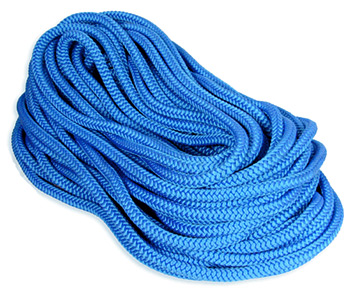
Leaves warehouse: 12 business days
- Copyright 1998-2024 SB Owners, LLC. All rights reserved.

- Policies | Contact Us
Country/region
- Australia USD $
- Austria USD $
- Belgium USD $
- Canada USD $
- Czechia USD $
- Denmark USD $
- Finland USD $
- France USD $
- Germany USD $
- Hong Kong SAR USD $
- Ireland USD $
- Israel USD $
- Italy USD $
- Japan USD $
- Malaysia USD $
- Netherlands USD $
- New Zealand USD $
- Norway USD $
- Poland USD $
- Portugal USD $
- Singapore USD $
- South Korea USD $
- Spain USD $
- Sweden USD $
- Switzerland USD $
- United Arab Emirates USD $
- United Kingdom USD $
- United States USD $

Item added to your cart
The art of choosing the perfect sailboat running rigging.
The Art of Choosing the Perfect Sailboat Running Rigging: A Comprehensive Guide
Introduction

Ahoy, fellow sailors! Embarking on the high seas and feeling the wind caress your face as you glide through the waters is an exhilarating experience. However, the true magic of sailing lies in the intricate details, and one of the most critical elements is the sailboat running rigging . A well-chosen and properly crafted line can make all the difference between smooth sailing and a chaotic journey. In this uber-detailed blog post, we'll dive into the art of selecting the right sailboat running rigging, exploring various materials, constructions, custom options, and the convenience of a messenger eye.
Understanding the Importance of Sailboat Running Rigging
Before we delve into the nitty-gritty of line selection, it's crucial to understand the significance of running rigging. These lines are responsible for controlling the sails and the overall performance of your sailboat. Each line has its specific purpose, be it controlling the main sail, jib, spinnaker, or other sails. Therefore, choosing the right line tailored to your sailing needs is paramount.
Materials for Sailboat Running Rigging
- Polyester (Dacron): Polyester ropes are popular for their excellent balance of durability, flexibility, and cost-effectiveness. They are ideal for cruising and recreational sailors who seek a reliable and budget-friendly option.
- Dyneema (HMPE): Dyneema, a high-performance synthetic fiber, is known for its extraordinary strength-to-weight ratio. It is significantly stronger than polyester and offers minimal stretch. Dyneema lines are perfect for racing and performance-oriented sailors who demand optimal responsiveness and lightness.
- Technora and Vectran: These are other high-performance synthetic fibers that offer exceptional strength and low stretch. Technora excels in handling high temperatures, making it suitable for specific racing applications, while Vectran provides excellent abrasion resistance.
Various Constructions for Sailboat Running Rigging
- Single Braid: This construction consists of a single continuous rope, making it lightweight, easy to handle, and less likely to kink. Single braids are suitable for halyards and control lines.
- Double Braid: Double braided lines have a core and a protective outer cover, combining durability with excellent grip and handling. They are versatile and suitable for a range of applications.
- Three-Strand: Three-strand ropes are traditional and cost-effective. They offer good grip and are easy to splice. They are commonly used for dock lines and some standing rigging applications.
- Uncovered Core: Lines with an uncovered core are easy to splice and are often chosen when custom splicing is required for adding shackles or creating tapered ends.
Custom Splicing and Tapering
At SendIt Sailing, we take pride in offering custom splicing services to our customers. Whether you need a shackle spliced on, a messenger eye, or a tapered end, our skilled artisans can craft the perfect line tailored to your specific requirements. Tapering the end of a line reduces its diameter, allowing smooth passage through blocks and pulleys, resulting in improved performance and reduced wear.
The Convenience of a Messenger Eye
A messenger eye on the unloaded end of a halyard is a small yet ingenious addition that can make your life much easier. This loop allows you to easily reeve a new line into the mast without any hassle, saving valuable time and effort during sail changes or maintenance. It's a small detail that can have a big impact on the overall sailing experience.
Wide Range of Halyard Shackles
At SendIt Sailing, we offer an extensive selection of halyard shackles from reputable brands like Wichard, Ronstan, Tylaska, and Harken. These high-quality shackles provide secure connections, ensuring the reliability of your rigging setup.
Selecting the right sailboat running rigging is an art that requires a deep understanding of sailing needs and the available materials and constructions. Polyester, Dyneema, Technora, and Vectran offer varying strengths and stretch characteristics, catering to different sailing styles. Single braids, double braids, and three-strand constructions each have their advantages, and the option of custom splicing and tapering allows you to fine-tune your rigging. Additionally, the messenger eye proves to be a handy addition for smoother maintenance and sail changes. As you set sail on your next adventure, remember that the perfect running rigging is not just a tool but an essential partner in your journey across the vast seas. Happy sailing!
Leave a comment
Please note, comments need to be approved before they are published.
- Choosing a selection results in a full page refresh.
- Opens in a new window.

Please verify you are a human
Access to this page has been denied because we believe you are using automation tools to browse the website.
This may happen as a result of the following:
- Javascript is disabled or blocked by an extension (ad blockers for example)
- Your browser does not support cookies
Please make sure that Javascript and cookies are enabled on your browser and that you are not blocking them from loading.
Reference ID: 7eec9ea9-e6e4-11ee-88db-67449b1b7f5b
Powered by PerimeterX , Inc.
Running Rigging for Sailboats: Everything You Need to Know
by Emma Sullivan | Aug 9, 2023 | Sailboat Maintenance

Short answer running rigging for sailboats:
Running rigging refers to the set of lines or ropes used to control the sails on a sailboat. It includes halyards, sheets, and control lines that regulate sail positioning, trim, and hoisting. These essential components are crucial for maneuverability and sail adjustment during sailing.
Introduction to Running Rigging for Sailboats: What You Need to Know
Sailing has captivated mankind for centuries, offering a unique sense of freedom as we harness the power of the wind to glide gracefully across the water. But behind this graceful dance lies an intricate system of ropes, lines, and cables known as running rigging. In this blog post, we’ll dive deep into the world of running rigging for sailboats and provide you with all the essential knowledge you need to embark on your sailing journey.
So, what exactly is running rigging? In simple terms, it refers to all the ropes and lines that control and adjust various parts of the sails on a sailboat . These components play a vital role in maneuvering your vessel and optimizing its performance on the water.
Let’s now take a closer look at some key elements of running rigging:
1. Halyards: Starting from the topmast, halyards are used to hoist or raise sails. There are different types of halyards depending on the type and size of sail being raised – genoa halyard for headsails, main halyard for mainsails, spinnaker halyard for spinnakers, etc. It’s crucial to have properly sized and well-maintained halyards that can withstand high loads while ensuring smooth operation.
2. Sheets: Sheets are lines connected to any control point on a sail such as clew (lower aft corner) or leech (outer edge). The primary function is to trim or adjust the shape and angle of your sail by controlling its tension. Jib sheets control headsail(s), while main sheets handle mainsails – their correct lengths contribute significantly to achieving optimal airflow over your sails .
3. Control Lines: These lines allow you to fine-tune specific aspects related to sail control . For example, cunningham (for mainsails) adjusts luff tension, outhaul regulates foot shape and tension (especially mainsails), and vang controls leech tension. These lines enable you to precisely tailor your sails to the ever-changing wind conditions, optimizing performance and speed.
4. Reefing Lines: When winds become too strong to handle full sails, reefing allows you to reduce sail area by partially furling or folding it. Reefing lines, often associated with booms or mast cars, make this process smooth and efficient. Understanding how to properly set up reefing lines is crucial for safety during inclement weather while ensuring your sailboat remains manageable in adverse conditions.
5. Lazy Jacks: Tired of dealing with a chaotic heap of lines when dropping your mainsail? Enter lazy jacks – an ingenious system that guides the sail down onto the boom neatly. These lines crisscross above the boom and effectively contain the falling sail until it rests securely on deck . Lazy jacks are a game-changer for solo sailors or those seeking a hassle-free experience when stowing their main sails .
6. Running Backstays: Designed for use on boats with fractional rigs or certain types of staysails, running backstays provide additional support to the mast from behind. By alleviating excessive mast bend under heavy loads, they enhance overall rig stability and performance in varying sailing conditions.
The world of running rigging offers endless possibilities for customization and upgradeability as per your specific sailing needs – whether you’re participating in racing competitions or unwind on leisurely cruises along coastal waters.
In conclusion, understanding running rigging is essential for any aspiring sailor looking to master their craft. It’s not merely a tangle of ropes; rather, it represents the fine art of controlling your vessel’s performance through precise adjustments of its sails and related components .
So next time you set sail on your magnificent vessel across sparkling waters, take a moment to appreciate the intricate web of ropes working together behind the scenes. Embrace the power and beauty of running rigging, knowing that it is your trusted friend in your quest for sailing excellence.
How to Choose the Right Running Rigging for Your Sailboat
Choosing the Right Running Rigging: The Art of Sailing Efficiency
When it comes to navigating the open water on your beloved sailboat, having the right running rigging in place can make all the difference in the world. But with so many options available, how do you go about selecting the perfect rigging that suits your sailboat ‘s needs? Fear not, as we are here to guide you through this challenging decision-making process.
First and foremost, one must understand that running rigging plays a vital role in optimizing the performance and safety of your sailboat. Essentially, it is a set of ropes and lines responsible for controlling various aspects of your boat’s sails during navigation. Now let’s dive into some considerations that will help you make an informed decision while choosing the ideal running rigging:
1. Understand Your Specific Requirements: Begin by assessing the specific needs of your sailboat . Are you a recreational sailor who enjoys leisurely cruises or an adventurous racer seeking maximum speed? The purpose and usage of your sailboat will heavily influence your choice of running rigging. Performance-oriented sailors may opt for high-tech materials such as Dyneema® or Spectra®, known for their exceptional strength-to-weight ratio.
2. Rope Selection – Material Matters: The material used for constructing running rigging significantly impacts its performance, durability, and handling. Traditional choices like polyester (Dacron) offer reliable strength at an affordable price point but may stretch over time. Alternatively, advanced fibers like Dyneema® provide excellent strength while being significantly lighter and less prone to elongation.
3. Tailoring Diameter Choices: While deciding on rope diameter may seem trivial initially, it holds immense importance in enhancing grip and ease of use for crew members aboard. Thicker lines tend to be more durable but might compromise handling efficiency due to increased bulkiness. Conversely, thinner lines offer improved flexibility but may lack adequate strength under heavy loads.
4. Understanding Line Construction: Different line constructions serve distinct purposes. A single braid construction, for example, offers enhanced grip and durability, whereas a double braid provides greater strength and handling flexibility. By considering the specific requirements and onboard conditions your sailboat faces, you can select the most appropriate line construction for optimal performance.
5. Balancing Stretch and Performance: Stretch is an inherent property of all ropes, but excessive elongation can adversely affect a sailboat’s maneuverability and overall power efficiency . For racers seeking maximum performance, low-stretch lines like Dyneema® are ideal. However, cruisers might prefer lines with moderate stretch to absorb shocks and prevent sudden jolts during maneuvers.
6. Colorful Choices for Easy Identification: While aesthetics may not seem critical when choosing running rigging at first glance, opting for lines that contrast against your sail colors can significantly improve crew coordination during hectic moments on board. Bold colors also make it easier to identify different lines quickly or spot potential tangles before they become problematic.
7. Seek Professional Advice: When in doubt or faced with multiple conflicting options, consulting professionals with extensive sailing experience can be invaluable. Sailmakers or rigging experts possess intricate knowledge of various rigging configurations suitable for different boat sizes and sailing styles. They can provide tailored recommendations based on your particular needs and constraints.
In conclusion, selecting the right running rigging requires careful consideration of factors such as boat usage, material selection, rope diameter, line construction, stretch characteristics, color coding possibilities, and professional advice where needed. Armed with this knowledge and a clear understanding of your sailboat’s requirements, you’ll navigate the vast seas efficiently while ensuring optimal safety and performance – seizing countless memorable adventures aboard your prized vessel!
Step-by-Step Guide: Setting Up Running Rigging for Your Sailboat
Setting up running rigging for your sailboat may seem like a daunting task, especially if you’re new to sailing. However, with this step-by-step guide, we’ll walk you through the process in a detailed, professional, witty, and clever way that will make it easy and fun!
Step 1: Assess Your Needs Before diving into setting up your running rigging, take some time to evaluate your sailing style and preferences. Consider factors like the size of your sailboat, the type of sailing you plan to do (racing or cruising), and any special requirements or equipment you might need.
Step 2: Gather Your Materials Now that you know what you need for your specific setup, gather all the necessary materials. This may include ropes (or lines), blocks, cleats, shackles, winches, and any other hardware required for your particular rigging configuration . Make sure to choose high-quality materials that can withstand the pressures of sailing.
Step 3: Plan Your Rigging Configuration Next up is planning! Think about how each line will be led through blocks or pulleys and where they will be attached on deck. This requires careful consideration as it affects both functionality and aesthetics. Aim for an organized layout that minimizes clutter while maximizing efficiency.
Step 4: Install Mast Hardware Start by installing any mast hardware needed for attaching halyards (lines used to raise sails) and other standing rigging components. Be precise in measuring distances between attachment points to ensure proper tension on the lines later on.
Step 5: Run Halyards With the mast hardware in place, run your halyards from their respective attachment points at the masthead down to where they will be managed on deck. Take care to avoid tangling ropes or creating unnecessary friction points along their path.
Pro Tip: As you work on this step, keep a witty pun jar nearby – every time you come up with a clever nautical pun, drop a quarter or dime. This will not only add some entertainment but also motivate you to think outside the box!
Step 6: Lead Control Lines Control lines, such as sheets and reefing lines, play a crucial role in adjusting sail trim and managing different sailing conditions. Run these rigging lines from their respective attachment points on the sails through blocks and down to the cockpit or other manageable locations.
Step 7: Cleat Securely Once you have all your running rigging lines in place, securely cleat them off at designated cleats on deck. Cleating properly is crucial for safety and ensures that your sails are appropriately tensioned while sailing.
Step 8: Test & Adjust Now it’s time for the moment of truth – test out your newly set-up running rigging! Take your sailboat out for a spin (pun intended), and pay attention to how smoothly the lines run through blocks and pulleys . Make any necessary adjustments to improve functionality or eliminate any unwanted friction points.
Final Thoughts Setting up running rigging for your sailboat may seem overwhelming at first, but by following this step-by-step guide with our witty tips along the way, you’ll be able to tackle this task with confidence. Remember, practice makes perfect when it comes to understanding how different adjustments affect boat performance.
So grab your materials, unleash your inner sailor wit, and get ready to enjoy smooth sailing with perfectly set-up running rigging!
Frequently Asked Questions About Running Rigging for Sailboats – Answered!
Running rigging plays a crucial role in the sailing of boats, providing control and maneuverability on the water. However, there are often questions surrounding this topic that can leave even experienced sailors scratching their heads. To help demystify running rigging for sailboats, we have compiled a list of frequently asked questions and provided comprehensive answers. So hoist those sails and get ready to explore the world of running rigging!
1. What exactly is running rigging? Running rigging refers to the various ropes used onboard a sailboat that control its sails, such as halyards, sheets, and control lines. Unlike standing rigging (the fixed cables and rods that support the mast), running rigging is adjustable and subject to frequent use during sailing maneuvers.
2. How important is choosing the right type of rope for my running rigging? Selecting the appropriate rope for your running rigging is paramount as it directly impacts performance on your boat. Factors like strength, stretch, weight, grip, and handling all come into play when choosing between materials like nylon, polyester, or Dyneema®️. Understanding these characteristics will enable you to optimize your sail ‘s efficiency and responsiveness.
3. Should I go for colored ropes or stick with plain white ones? While aesthetics play a role in color choice for running rigging, functionality should always take precedence over style. Colored ropes can aid in differentiating between different types of lines quickly and conveniently. For example, using red for port side lines and green for starboard side lines can eliminate confusion under pressure situations where clarity is crucial.
4. Are there any essential knots every sailor should know when dealing with running rigging? Absolutely! Learning some basic knots will greatly assist you when working with your boat’s running rigging system. The bowline knot allows you to make a secure loop at the end of a line while maintaining its strength. The cleat hitch helps you secure a line around a cleat, while the figure-eight knot prevents the end of a line from slipping through blocks or other hardware.
5. Can I easily replace my running rigging on my own, or should I seek professional assistance? Replacing your running rigging can often be done by sailors with some DIY skills and knowledge. However, it’s essential to consult with sailboat experts or riggers to ensure proper material selection and installation techniques. Their expertise can help you avoid rigging mishaps and costly mistakes that could jeopardize your safety on the water.
6. How frequently should running rigging be inspected and replaced? Regular inspection is crucial to assess the condition of your running rigging and identify any signs of wear or damage. Depending on usage and exposure to environmental elements like UV rays, you might need to replace certain lines every few years or sooner if they show visible signs of deterioration. Remember, prevention is always better than cure when it comes to sailing equipment .
7. What are some common mistakes to avoid when dealing with running rigging? One common mistake is neglecting regular maintenance and inspection of your running rigging, which can lead to unexpected failures at critical moments while sailing. Another mistake is overlooking proper line handling techniques like coiling ropes correctly to prevent kinks or twists that could compromise their strength.
In conclusion, understanding the ins and outs of running rigging is vital for any sailor looking to optimize their boat’s performance on the water. By selecting suitable ropes, learning essential knots, seeking professional advice when needed, regularly inspecting lines, and avoiding common pitfalls, you will ensure smooth sailing adventures through cleverly managed running rigging systems!
Essential Tips and Tricks for Maintaining Running Rigging on Your Sailboat
Maintaining running rigging on your sailboat is crucial for both efficiency and safety on the water. Your sailboat’s running rigging, including halyards, sheets, and control lines, play a vital role in adjusting sail shape and controlling the sails’ position. Here are some essential tips and tricks to help you keep your running rigging in top-notch condition.
1. Choose High-Quality Materials: Investing in quality running rigging materials might cost you a bit more upfront, but it will save you time and money in the long run. Opt for durable ropes made of materials like Dyneema or Spectra that offer excellent strength-to-weight ratios and resistant to UV damage.
2. Regular Inspection: Before every sailing trip, get into the habit of thoroughly inspecting your running rigging. Look out for signs of wear, fraying, or any other damage that may compromise their performance. Pay extra attention to areas where there is increased friction or stress points.
3. Cleanliness Is Key: Saltwater and dirt can accelerate rope degradation, so make sure to regularly clean your running rigging using mild soap and water. Rinse them well afterwards to remove any residue that can cause corrosion or weaken the fibers.
4. Protect From UV Rays: Prolonged exposure to sunlight can weaken ropes over time due to UV degradation. Apply a high-quality UV protector or use protective covers at chafe points to keep your running rigging shielded from harmful rays.
5. Proper Coiling and Storage: Coiling your lines correctly not only makes them easier to handle but also helps maintain their integrity over time. Avoid kinks by loosely coiling lines in large loops instead of tightly winding them around your arm or a winch handle. Store coils away from direct sunlight in a dry space to prevent mildew growth.
6. Lubricate Moving Parts: To ensure smooth operation of blocks, cleats, and other moving parts in your running rigging, apply a silicone or dry lubricant. Avoid greasy lubricants as they attract dirt and can lead to clogged systems or premature wear.
7. Tension Adjustment: Regularly adjust the tension of your running rigging to ensure optimal sail performance and safety. Over time, ropes may stretch or shrink due to exposure to environmental conditions, so keeping a keen eye on their tension is vital.
8. Replace Worn Out Lines: No matter how well you maintain your running rigging, there will come a time when replacement is necessary. Don’t hesitate to retire old and worn-out lines and replace them with new ones to maintain the highest level of safety and performance.
By following these essential tips and tricks for maintaining running rigging on your sailboat, you’ll not only extend their lifespan but also enhance your sailing experience. Regular inspection, proper cleaning, storage, and tension adjustment are all part of responsible boat ownership that ensures both efficiency and safety on the water. So take care of your running rigging like a pro sailor would, and enjoy smooth sailing adventures for years to come!
Advanced Techniques: Upgrading and Fine-Tuning Your Sailboat’s Running Rigging
Are you ready to take your sailboat to the next level? Upgrading and fine-tuning your running rigging is a thrilling endeavor that can greatly enhance your sailing experience. In this blog, we will delve into advanced techniques that will make your sailboat perform at its peak, ensuring smooth navigation and unbeatable speed on the water. So buckle up and get ready for an exhilarating ride!
First off, let’s address the importance of upgrading your sailboat’s running rigging. While it may seem like a daunting task, it is essential in optimizing performance and overall handling. Rigging plays a critical role in controlling the sail shape and maximizing efficiency, whether you’re cruising or racing.
One of the key areas to focus on is replacing old lines with high-performance ones. Technological advancements have given rise to innovative rope materials such as Dyneema or Spectra, which offer superior strength-to-weight ratios and low stretch properties. By using these modern marvels, you’ll experience minimal loss of power due to line sag or stretch – translating into more efficient power transfer from wind to acceleration.
Additionally, consider updating hardware components such as blocks or sheaves with newer models designed specifically for high loads and reduced friction. These upgrades enable smoother movements during maneuvers like tacking or gybing, boosting maneuverability while decreasing effort required at the helm.
Now let’s talk about fine-tuning techniques that can elevate your sailing game even further. One method involves adjusting line tension through various control points on deck. By experimenting with different configurations – tweaking halyards, outhauls, cunninghams, vangs, backstays – you can optimize sail shape for different wind conditions. The ultimate goal is achieving an aerodynamically balanced set of sails that maximize lift while minimizing drag.
Another valuable technique worth mastering is proper lead placement for your running rigging. This refers to positioning blocks or cleats in optimal locations along the deck, allowing for smooth line movement and ideal angles. Correct lead placement can transform the way your sailboat responds to wind shifts, providing unrivaled control and responsiveness in any sailing situation.
To fine-tune your rigging even further, consider installing adjustable backstays or runners. These additions allow for precise control over mast bend, thus altering the shape of the mainsail. Such adjustments are invaluable when adjusting sailing performance as weather conditions evolve throughout a race or cruise – making you one step ahead of your competition or ensuring a comfortable journey.
Of course, all these advanced techniques require skill and knowledge to execute properly . It’s highly recommended to consult with experienced riggers or sailmakers who can guide you through the process. They can offer expert advice on choosing the right materials and equipment, as well as assist in setting up initial configurations based on your sailboat’s dimensions and intended purpose.
In conclusion, upgrading and fine-tuning your running rigging is an exciting venture that will take your sailboat from ordinary to extraordinary. By using high-performance lines, upgrading hardware components, adjusting line tension strategically, placing leads optimally, and introducing adjustable rigging elements such as backstays or runners- you’ll unleash the true potential of your vessel. So don’t delay – embark on this thrilling journey today!
Recent Posts

- Sailboat Gear and Equipment
- Sailboat Lifestyle
- Sailboat Maintenance
- Sailboat Racing
- Sailboat Tips and Tricks
- Sailboat Types
- Sailing Adventures
- Sailing Destinations
- Sailing Safety
- Sailing Techniques
- AROUND THE SAILING WORLD
- BOAT OF THE YEAR
- Email Newsletters
- Best Marine Electronics & Technology
- America’s Cup
- St. Petersburg
- Caribbean Championship
- Boating Safety

Simple Ways to Optimize Running Rigging
- By Erik Shampain
- December 6, 2022
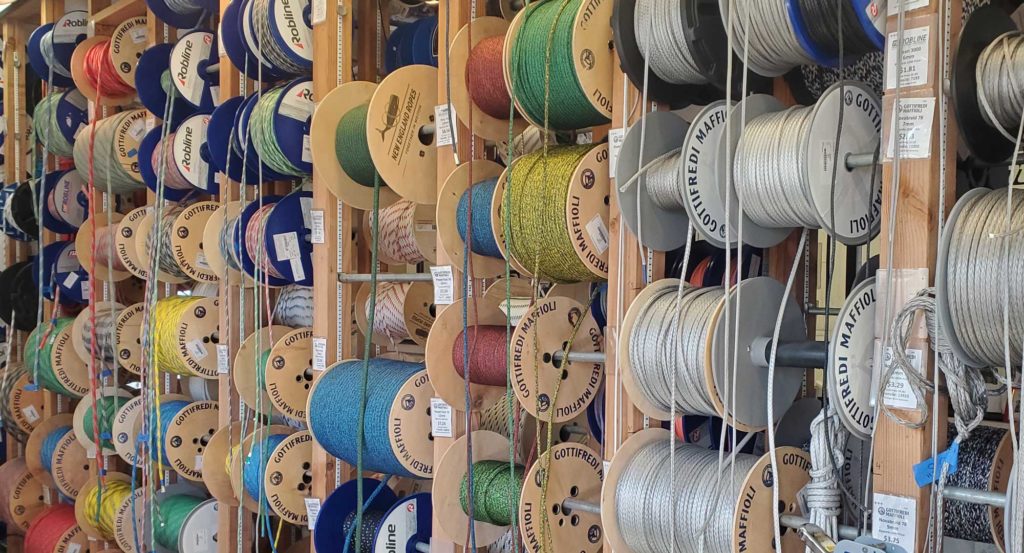
It’s easy to underestimate the benefits of good running rigging. There are many rope products on the market, and there is a time and a place for most of them. Let’s take a look at lines that need the most attention and why, as well as basic rules for using low-stretch line, using lightweight or tapered line where most beneficial and using rope that is easy to work with.
Let’s start up front with the headsail halyard. Luff tension greatly affects shape and thus performance of the jib or genoa, so having a halyard that is as low-stretch as possible is paramount. Saving a little weight aloft is also key, so find a lightweight rope as well. It’s a little against the norm, but for club racing boats that aren’t tapering their halyards, I really like some of the Vectran-cored ropes. Products like Samson’s Validator and New England Ropes V-100 are easy on the hands and easy to splice. For a little more grand-prixed tapered halyard, talk to our local rigger about using a DUX core, or other heat-set Dyneema, with a Technora-based cover. Lately, I’ve been using a lot of Marlow’s D12 MAX 78 and 99. Tapering the halyard saves weight aloft as well. I like soft shackles for jib halyards. There, weight savings aloft generally outweighs the little extra time a bowman needs to attach the sail. This is especially true in sprit boats where the jib is rarely removed from the headstay.
Pro Tip: When not racing, use a halyard leader to pull the halyards to the top of the mast, getting the tapered section out of the sun. For extra protection, put all the halyard tails into an old duffle bag at the base of the mast when not in use.
For jib sheets, I follow the same low-stretch rule as the jib halyard. I don’t want the jib sheet to stretch at all when a puff hits. On boats with overlapping genoas, I don’t generally recommend tapering the line because by the time the genoa is trimmed all the way in, the clew is really close to the block. On boats with non-overlapping jibs, tapering is an easy way to save a little weigh. Plus, the smaller core size runs through across the boat more easily in tacks. I’ve been using soft shackles on the jib or genoa sheets for a while now, mostly because they don’t beat the mast up during tacks. There also a bit “softer” when they hit you.
What about jib lead adjusters? There are a couple of approaches here. Some believe a little stretch is okay, as it allows the lead to rock aft a couple of millimeters in puffs, which twists the top of the jib off slightly. This can be fast as it helps the boat transition through puffs and lulls. I am a fan of this as long as it isn’t too stretchy. I use low-stretch Dyneema for the gross part of the purchase and then a friendlier-on-the-hands rope for the fine tune side, the part that is being handled. Samson Warpspeed or New England Enduro Braid work well.
Spinnaker sheets are a fun one. They should be relatively low-stretch but not necessarily the lowest stretch. I’ve found that near-zero stretch lines can wreak havoc on people and hardware when flogging or when the chute is collapsing. They have to be easy on the hands, as they are the most moved sheets on the boat, and they should be tapered as far as you can get away with. Tapering saves weigh, which is very important in keeping the spinnaker clew lifting up, especially in light air when sails want to droop. Again, Samson Warpseed and New England Enduro braid are good. For boats with grinders or even small boats with no winches, a cover that is a little grippier or stronger is good. Most Technora-based covers work well for this purpose.
Pro Tip No. 2: On boats with asymmetric spinnakers I like to connect the ‘Y’ sheet with a soft shackle that also goes to the spinnaker. This saves weight. I sew a Velcro strip around one part of the shackle (see picture) so that the soft shackle stays with the ‘Y’ sheet when open. This is beneficial when you have to quickly disconnect or re-run a sheet, replace one sheet, or even quickly replace a soft shackle. On most boats I will keep one spare spinnaker sheet with soft shackle down below as a spare side, changing sheet, or code zero sheet. On boats with a symmetric spinnaker, we’ll splice the spinnaker sheet to the afterguy shackle to save weight in the clew.
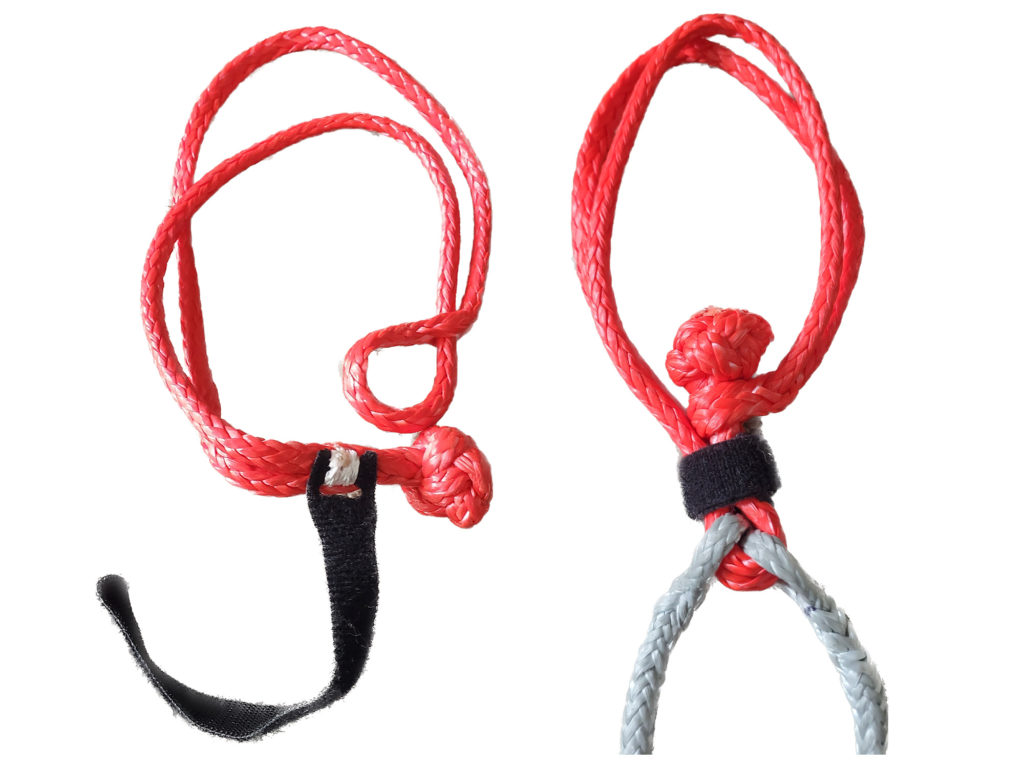
The spinnaker halyard has a couple of more options. For halyards supporting code zeros, zero stretch is important. The same principals we used when talking about the jib halyard apply here. For boats without code zeros, I like a little softer halyard with a touch of give. Those tend to run though sheaves better without kinking. Enduro and Warpseed are good for these applications. Most bowmen prefer a shackle that is quick and easy to open. Since a happy bowman is a good thing, I will generally use an appropriately sized Tylaska shackle or dogbone style shackle for those halyards
For symmetric spinnaker boats, the afterguy must be very low stretch line. I go back to products like covered Vectran for club-level sheets. I also find that afterguys generally last longer if I don’t taper them. When the pole is squared back, the afterguys often run pretty hard across the lifelines, producing a fair amount of chafe. Covered lines help minimize that.
For tack lines on asymmetric boats, I like matching spinnaker halyard material on club-level boats and using low-stretch heat-set Dyneema cores with a chafe resistant cover for grand prix and sportboats.
Like the headsail halyard, a near-zero stretch main halyard is also important. For me the same line applications apply. Keep the mainsail head at full hoist at all costs. I will often match the material I use for main and jib halyards.
It is most important that the main sheet sit in the winch jaws well and tail perfectly. This is a strict combination of sizing and pliability. I’ve found that the New England Ropes Enduro braid and the Samson Warpspeed II work well for club-level boats with and without winches. For a slightly longer lasting product with some chafe resistance, try any manufacturer’s Technora-based covered line.
The most under-appreciated and least thought about rope on a boat always seems to be the outhaul. The last thing you want when the wind comes up is for your mainsail to get fuller. Spend some time here and use very low-stretch rope. Most heat-set Dyneemas will work great for the gross tune side of the purchase.
Pro Tip No. 3: Minimizing the last purchase of an outhaul greatly increases the ease with which it can be pulled on or eased out. For example, you could have a 6-to-1 to one pulling a 2-to-1, pulling a 2-to-1 and then to the sail for a 24-to-1. Or, better yet, you could have a 4-to-1 pulling a 3-to-1, pulling a 2-to-1 for a 24-to-1 as well. The latter example will work better. Trust me. I’m a doctor . . . sort of. We built an outhaul like this on a SC50. I can pull it on upwind in heavy air with little problem. On the flip side, in light air downwind, it eases just as well. In fact, if memory serves me right, we did a 3-to-1 in the end rather than the 4-to-1 for a total of 18-to-1 and it worked well.
Runners and backstays should have extremely low stretch. A pumping mast and sagging forestay in breeze isn’t fast. Runner tails, like the mainsheet, should perfectly fit the winch and tail easily without kinking.
With so many options readily on the market now, it can be very confusing. I always recommend contacting your local rigger if you have any questions at all about what rope is right for you. They’ll get you pulling in the right direction.
- More: cordage , running rigging , sailboat gear
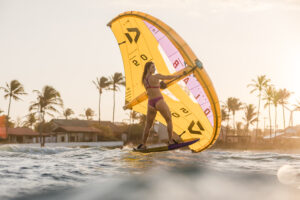
Wingfoiling Gear: A Beginner’s Guide
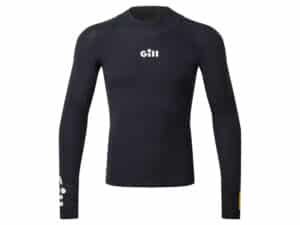
Suiting Up with Gill’s ZenTherm 2.0

Gill Verso Lite Smock Keeps it Simple
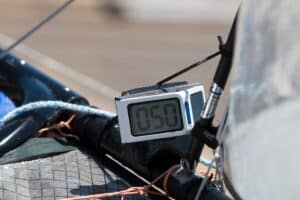
A Better Electronic Compass

Brauer Sails into Hearts, Minds and History

Anticipation and Temptation

America’s Offshore Couple

Jobson All-Star Juniors 2024: The Fast Generation

- Digital Edition
- Customer Service
- Privacy Policy
- Cruising World
- Sailing World
- Salt Water Sportsman
- Sport Fishing
- Wakeboarding
- New Sailboats
- Sailboats 21-30ft
- Sailboats 31-35ft
- Sailboats 36-40ft
- Sailboats Over 40ft
- Sailboats Under 21feet
- used_sailboats
- Apps and Computer Programs
- Communications
- Fishfinders
- Handheld Electronics
- Plotters MFDS Rradar
- Wind, Speed & Depth Instruments
- Anchoring Mooring
- Running Rigging
- Sails Canvas
- Standing Rigging
- Diesel Engines
- Off Grid Energy
- Cleaning Waxing
- DIY Projects
- Repair, Tools & Materials
- Spare Parts
- Tools & Gadgets
- Cabin Comfort
- Ventilation
- Footwear Apparel
- Foul Weather Gear
- Mailport & PS Advisor
- Inside Practical Sailor Blog
- Activate My Web Access
- Reset Password
- Pay My Bill
- Customer Service

- Free Newsletter
- Give a Gift

How to Sell Your Boat

Cal 2-46: A Venerable Lapworth Design Brought Up to Date

Rhumb Lines: Show Highlights from Annapolis

Open Transom Pros and Cons

Leaping Into Lithium

The Importance of Sea State in Weather Planning

Do-it-yourself Electrical System Survey and Inspection

Install a Standalone Sounder Without Drilling

When Should We Retire Dyneema Stays and Running Rigging?

Rethinking MOB Prevention

Top-notch Wind Indicators

The Everlasting Multihull Trampoline

How Dangerous is Your Shore Power?

DIY survey of boat solar and wind turbine systems

What’s Involved in Setting Up a Lithium Battery System?

The Scraper-only Approach to Bottom Paint Removal

Can You Recoat Dyneema?

Gonytia Hot Knife Proves its Mettle

Where Winches Dare to Go

The Day Sailor’s First-Aid Kit

Choosing and Securing Seat Cushions

Cockpit Drains on Race Boats

Rhumb Lines: Livin’ the Wharf Rat Life

Re-sealing the Seams on Waterproof Fabrics

Safer Sailing: Add Leg Loops to Your Harness

Waxing and Polishing Your Boat

Reducing Engine Room Noise

Tricks and Tips to Forming Do-it-yourself Rigging Terminals

Marine Toilet Maintenance Tips

Learning to Live with Plastic Boat Bits
- Sails, Rigging & Deck Gear
Testers Examine Running Rigging Options
Braided lines face torture tests to determine the top picks for halyards and sheets..
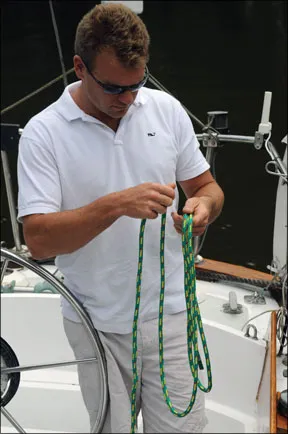
The first sign of cordage use dates back about 28,000 years. Archeological findings in Europe have carbon dating confirmation of twine imprints found in clay shards. The Egyptians (circa 4,500 BC) appear to be the first to utilize rope-making tools, and for millennia, natural fibers such as hemp, manila, sisal, jute, cotton, and others were the material of choice when it came to making laid or twisted rope.

Photos by Ralph Naranjo
The playing field changed in 1935 when DuPonts young research director Wallace Carothers and his team came up with a synthetic polymer dubbed nylon, a fiber that soon found its way into stockings, toothbrushes, and the capable hands of rope manufacturers around the world. Polyethylene terephthylate, another long-chain polymer, was synthesized in Britain in the 1940s, and eventually found its way into the DuPont lineup as Terylene in 1951. Terylene was rechristened Dacron, and the new polyester fiber soon joined nylon on the rope walks of cordage manufacturers around the world.
Dacron proved to be much less stretchy than nylon, 90 percent as strong, and more resistant to ultraviolet (UV) rays. Nylon and Dacron grew to be nautical buzzwords indicative of the rope of the future, at least up until chemical engineers with post doctoral degrees and ample grant dollars got serious about conjuring up new fibers. Today, Spectra, Vectran, Technora, and a whole host other tongue-twisters are the new, new thing in fiber technology. Truly stronger than steel, and 10 times lighter, they offer much less stretch and double or triple the tensile strength of the synthetic prototypes nylon and Dacron. Unfortunately, some also have inherent downsides such as reaction to UV, creep (permanent deformation under stress or heat), and the reluctance to be wrapped around a tight radius.
Fiber to Rope
For centuries, cordage was made in a time-honored tradition that began with fibers being spun into yarns, twisted together into strands, and finally twisted again in the opposite direction combining the strands into a rope. The opposing twists locked the bundle in place, and when tension was added to such three-strand laid ropes, the yarns torqued and rubbed against one another in response to elongation.
When it comes to making running rigging aboard sailboats, laid rope takes a back seat to braided line. The 26 samples of rope we evaluated for this test, all fall into what can be called braided rope. We looked at 24 ropes with braided covers that comprised eight, 12, even 24 tows combined in patterns ranging from loose to tight weaves. Most incorporated a braided core, although a few ropes had parallel-strand cores. Two samples of Amsteel, a single-braid rope, were included in the test for comparative purposes. By doing away with most of the twist involved in laid rope, braided lines tend to have less stretch, and the fiber bundles can be better aligned with load paths.
In early Dacron braided line, the tensile strength was usually evenly distributed (50-50 split) between the cover and core. Todays crop of high-tech lines often favors an uneven load distribution between the cover and the core. One example of this approach is found in a type of braided rope known as kernmantle, which comprises a braided cover and a high-tensile, parallel-strand core. In this design, the tensile strength is often split 70-30, with the core carrying most of the load. Such load sharing means that even when abrasion has jeopardized the outer cover, the cordage still retains most of its original tensile strength. Mountaineering rope-just like anchor and mooring line-can be engineered to retain such a cache of tensile strength in the center.
The flip side of this approach, however, is that once the cover of a sheet, guy, or halyard frays, it is time to replace the line regardless of how much tensile strength is still left deeper in the core. So cordage manufacturers have been engineering braided rope comprising a tough, abrasion resistant cover and a core that meets the required tensile strength. In addition to careful selection of cover fiber, engineers have turned to anti-abrasion urethane coatings that reduce the damaging effects of abrasion, UV, and acid rain. In this round of testing, testers directly measured the abrasion resistance of each line, tested its resistance to stretch and observed how it coiled, handled, and behaved on a winch drum. (See “How We Tested.”)
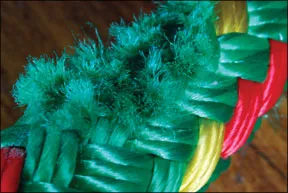
A Note on Breaking Strength
Breaking strength figures listed in the above table are astounding and represent the end of the line both figuratively and literally. At that point, the line has elongated as far as its elastic and plastic limits allow, and when it exceeds its yield, the result is an explosive bang. According to the Cordage Institute, the rope industrys amalgam of technical gurus, safe working loads (SWL) are five to 12 times less than the breaking strength for non “lifeline” uses. When used as a safety line, the SWL is calculated by dividing the breaking strength by 12 or more. The reason for this seemingly hyper-conservative safety margin is because shock loading can cause the static tensile load to skyrocket, and there needs to be plenty of safety margin to compensate for these momentary spikes.
What We Found
With so many lines to consider, we grouped the products by material and construction, more or less keeping the apples, oranges, and bananas in separate boxes. We began the process by sorting the rope into three fairly distinct performance groups (low, mid, and high tech) based upon their fiber content. Once sorted, the ropes were evaluated for their elongations, abrasion resistance, and handling. Results are tabulated on the pages above.
There were similarities among the types of ropes manufactured and marketed by different companies. For example, each offered a polyester double braid that afforded excellent UV stability and handling characteristics at a bargain price. However, these lines were also the most prone to elongation under even modest working load, and were poor candidates as halyard material.
Testers confirmed that high-modulus fibers and new coating treatments do enhance performance traits in rope. Theres no question that fibers such as Technora, Dyneema, and Vectran boost the breaking strength of rope and lessen stretch, but theres also a flip side that needs to be taken into consideration. Many of these fibers have an inherent stiffness and tendency to hockle that makes them hard to coil and handle. Notice that many of the higher performing ropes scored low for handling.
Whether you should make low-stretch or easy-handling a priority will depend upon the ropes application. A conventional all-Dacron 7/16-inch halyard may easily have 60 feet of its length in tension, and with normal sailing conditions, halyard stretch could be as much as 16.4 inches. Swap out the all-polyester halyard and replace it with a high modulus, 3/8-inch diameter rope such as Yales Maxibraid Plus and the stretch is reduced to 4.1 inches.
This four-time reduction in elongation makes a big difference in mainsail draft control. The last thing a crew wants is more draft in the mainsail just as a gust fills in. The bottom line when it comes to halyards is that its worth putting up with a line that coils like a tree branch, if once it is winched into place, it resists elongation as well as wire.
Sheets on a cruising boat are quite a different story. Most short-handed, long range passagemakers arent obsessed with continuous trimming and turn the drudgery over to an autopilot. Sail trim consists of an occasional look at sail shape and telltale behavior. Eliminating the last bit of stretch in a sheet is of little advantage, but having a line that can put up with the abrasion, UV harassment, and the fatigue that adds up during days, or weeks at sea is a vital asset. Handling ability is another key factor, especially with so many lines leading to the cockpit. A halyards can’tankerous demeanor is tolerable, since the rope is effectively a set-it-and-forget-it one-act play. But sheets are handled more often, and easily coiled tails are always appreciated by every crew.
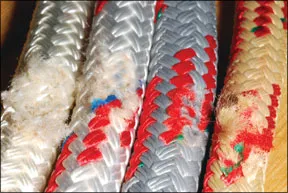
Ultimately, when all the stretching, abrading, and coiling was done, testers were able to find some clear choices based on price range and offer some general guidance for those who are shopping for new cordage.
Budget ropes: At the low-tech and lower cost end of the spectrum, Samsons SLX 456 nudged ahead of competitors. Yales Yacht Braid, New England Ropes Sta-Set and Novabraid XLE were all high- quality polyester double braids. Each made the grade as an easy-to-handle general purpose cordage, but none was optimized for use as a halyard material. The reason Samson SLX topped our list was its superior showing in the abrasion test, a feature of its cover construction and proprietary coating process.
Sta-Set X by New England Ropes took polyester cover-and-core technology to a higher performance level, keeping the price down but sacrificing some handling ease and abrasion resistance in the process. The cover has an odd feel, and coiling is not as easy as with the other all-polyester products, but stretch has been reduced significantly and tensile strength was upped by 10 percent or so. This has been accomplished through the use of parallel yarns in the core. The bottom line is that this is an all-polyester line that can be used as a halyard, and it retains the price-point advantage found in all polyester ropes.
Mid-range value: Five of the products we tested are grouped as mid-price, mid-level performers, and the stats speak for themselves. Our favorite in this grouping was New England Ropes VPC. This line isn’t as nice to handle as the all-polyester braids, but it has 50 percent less stretch, superior abrasion resistance, and a price that is half that of the top contenders. Yales Vizzion rated a solid “Good” across the board but had a lower breaking strength. New England Ropes T-900, a low-stretch and high-tensile strength alternative, was especially stiff to handle, and its smaller-diameter 5/16-inch version was more prone to cover abrasion. Samson entered a larger 7/16-inch diameter sample of XLS Extra-T, and even with the extra diameter advantage, its stretch was greater than VPC. However, this tuned-up XLS has many excellent attributes. It slips onto and grips a winch drum nicely and handles very well, making it an excellent choice for sheets-if you can handle the extra expense.
Big bucks for the best: The skys the limit at the upper end of the cordage range. In fact, rope made with esoteric PBO (Zylon) is so costly that we left it out of our evaluation altogether, calling the game at line that pushed to $4 foot in the discount houses. In this grouping, we find rope with the highest breaking strength, the most cover abrasion resistance, and the least stretch. Evidently, you do get what you pay for when it comes to cordage. The reason New England Ropes Endura Braid and Yales Maxi Braid Plus topped our list was that they delivered the three features mentioned above, but also garnered high marks for handling.

Samsons Amsteel was hard not to like. The 15-foot section of 5/16-inch single braid Dyneema took abrasion testing in stride, was soft and supple, weighed in at just 5.5 ounces, and had little more bulk than a handful of shoelaces. Yet it was strong enough to support a pickup truck with a couple of J/24 keels in the bed. The downside was how the all Dyneema line behaves on a winch drum. Its lubricity or slipperiness combines with a coating that glazes under pressure, creating a line thats difficult to set and ease on a winch drum. Despite this complaint, it makes a superb halyard-just use a winch with a well-textured drum face. Its also worthwhile to keep a good supply of this line in the damage control kit, for emergency lashings and jury-rigging.
The least surprising verification from our testing was the inverse relationship between stretch and cost. Esoteric, low-stretch fibers come with a higher price tag, and the old saga of paying more for performance played out in spades. However, the real surprise came when PS started looking to fill in the “street” prices for specific products. Searching West Marine, Defender, Mauri Pro, PYacht, Jamestown Distributors, Boat Locker, and a few other sources, testers discovered a wide range in discounted prices per foot. In some cases, there were 60-percent variations for the identical product. The figures in our table serve as a good guide, but smart rope buying is most certainly a shop-around enterprise.
Dont buy more tech than youre going to put to use. From our perspective, it makes sense to invest a little extra in a good mainsail halyard. Unless youre a hard-core competitor, the genoa that rides in a roller-furler luff grove doesn’t need as much no-stretch chemistry. When it is blowing hard, and the jib is partially furled, the load dynamics spread out to the entire foil headstay and halyard, and some luff sag is expected. Those who still fly a conventional spinnaker will love the reduced stretch of high-tech cordage in an after guy. Lighter weight, no water absorption, and smaller diameter light air sheets can also improve ghosting performance. A lightweight mainsheet with good handling characteristics and a low desire to twist can also be worth the investment.
In short, the polyester double-braided lines are like hubcaps over steel rims-just plain practical. Ratchet up to lines with less stretchy fiber blends in the core, and youve arrived at an all-around good compromise. For those who don’t choke on the $3-per-foot pricetag for hundreds of feet of line, there are spools of great technology just itchin to make sailing faster, easier, and more costly.
- How We Tested
- Practical Sailor Value Guide: Braided Cover Running Rigging Performance
- Download PDF Format
RELATED ARTICLES MORE FROM AUTHOR
Leave a reply cancel reply.
Log in to leave a comment
Latest Videos

Island Packet 370: What You Should Know | Boat Review

How To Make Starlink Better On Your Boat | Interview

Catalina 380: What You Should Know | Boat Review
- Privacy Policy
- Do Not Sell My Personal Information
- Online Account Activation
- Privacy Manager
- Types of Sailboats
- Parts of a Sailboat
- Cruising Boats
- Small Sailboats
- Design Basics
- Sailboats under 30'
- Sailboats 30'-35
- Sailboats 35'-40'
- Sailboats 40'-45'
- Sailboats 45'-50'
- Sailboats 50'-55'
- Sailboats over 55'
- Masts & Spars
- Knots, Bends & Hitches
- The 12v Energy Equation
- Electronics & Instrumentation
- Build Your Own Boat
- Buying a Used Boat
- Choosing Accessories
- Living on a Boat
- Cruising Offshore
- Sailing in the Caribbean
- Anchoring Skills
- Sailing Authors & Their Writings
- Mary's Journal
- Nautical Terms
- Cruising Sailboats for Sale
- List your Boat for Sale Here!
- Used Sailing Equipment for Sale
- Sell Your Unwanted Gear
- Sailing eBooks: Download them here!
- Your Sailboats
- Your Sailing Stories
- Your Fishing Stories
- Advertising
- What's New?
- Chartering a Sailboat
- Running Rigging
Sailboat Rigging: Part 2 - Running Rigging
Sailboat rigging can be described as being either running rigging which is adjustable and controls the sails - or standing rigging, which fixed and is there to support the mast. And there's a huge amount of it on the average cruising boat...
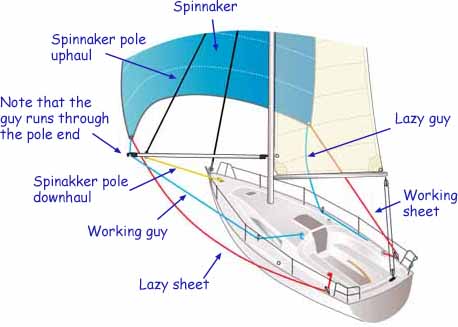
- Port and starboard sheets for the jib, plus two more for the staysail (in the case of a cutter rig) plus a halyard for each - that's 6 separate lines;
- In the case of a cutter you'll need port and starboard runners - that's 2 more;
- A jib furling line - 1 more;
- An up-haul, down-haul and a guy for the whisker pole - 3 more;
- A tackline, sheet and halyard for the cruising chute if you have one - another 3;
- A mainsheet, halyard, kicker, clew outhaul, topping lift and probably three reefing pennants for the mainsail (unless you have an in-mast or in-boom furling system) - 8 more.
Total? 23 separate lines for a cutter-rigged boat, 18 for a sloop. Either way, that's a lot of string for setting and trimming the sails.
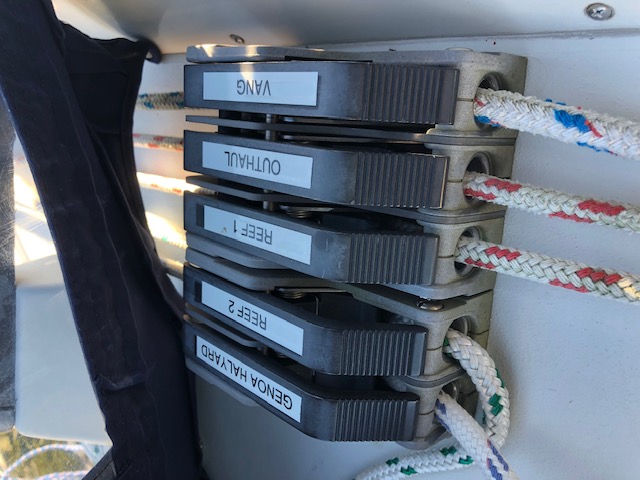
Many skippers prefer to have all running rigging brought back to the cockpit - clearly a safer option than having to operate halyards and reefing lines at the mast. The downside is that the turning blocks at the mast cause friction and associated wear and tear on the lines.
The Essential Properties of Lines for Running Rigging
It's often under high load, so it needs to have a high tensile strength and minimal stretch.
It will run around blocks, be secured in jammers and self-tailing winches and be wrapped around cleats, so good chafe resistance is essential.
Finally it needs to be kind to the hands so a soft pliable line will be much more pleasant to use than a hard rough one.
Not all running rigging is highly stressed of course; lines for headsail roller reefing and mainsail furling systems are comparatively lightly loaded, as are mainsail jiffy reefing pennants, single-line reefing systems and lazy jacks .
But a fully cranked-up sail puts its halyard under enormous load. Any stretch in the halyard would allow the sail to sag and loose its shape.
It used to be that wire halyards with spliced-on rope tails to ease handling were the only way of providing the necessary stress/strain properties for halyards.
Thankfully those days are astern of us - running rigging has moved on a great deal in recent years, as have the winches, jammers and other hardware associated with it.
Modern Materials
Ropes made from modern hi-tech fibres such as Spectra or Dyneema are as strong as wire, lighter than polyester ropes and are virtually stretch free. It's only the core that is made from the hi-tech material; the outer covering is abrasion and UV resistant braided polyester.
But there are a few issues with them:~
- They don't like being bent through a tight radius. A bowline or any other knot will reduce their strength significantly;
- For the same reason, sheaves must have a diameter of at least eight times the diameter of the line;
- Splicing securely to shackles or other rigging hardware is difficult to achieve, as it's slippery stuff. Best to get these done by a professional rigger...
- As you may have guessed, it's expensive stuff!
My approach on Alacazam is to use Dyneema cored line for all applications that are under load for long periods of time - the jib halyard, staysail halyard, main halyard, spinnaker halyard, kicking strap and checkstays - and pre-stretched polyester braid-on-braid line for all other running rigging applications.
Approximate Line Diameters for Running Rigging
But note the word 'approximate'. More precise diameters can only be determined when additional data regarding line material, sail areas, boat type and safety factors are taken into consideration.
Length of boat
Spinnaker guys
Boom Vang and preventers
Spinnaker sheet
Genoa sheet
Main halyard
Genoa / Jib halyard
Spinnaker halyard
Pole uphaul
Pole downhaul
Reefing pennants
Lengthwise it will of course depend on the layout of the boat, the height of the mast and whether it's a fractional or masthead rig - and if you want to bring everything back to the cockpit...
Read more about Reefing and Sail Handling...
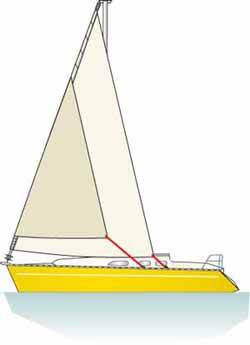
Headsail Roller Reefing Systems Can Jam If Not Set Up Correctly
When headsail roller reefing systems jam there's usually just one reason for it. This is what it is, and here's how to prevent it from happening...
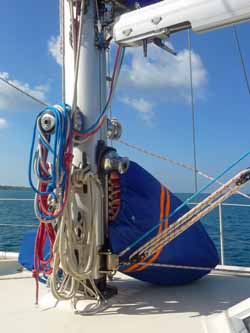

Single Line Reefing; the Simplest Way to Pull a Slab in the Mainsail
Before going to the expense of installing an in-mast or in-boom mainsail roller reefing systems, you should take a look at the simple, dependable and inexpensive single line reefing system
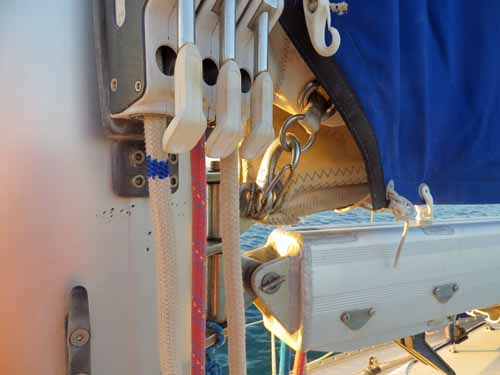
Is Jiffy Reefing the simplest way to reef your boat's mainsail?
Nothing beats the jiffy reefing system for simplicity and reliability. It may have lost some of its popularity due to expensive in mast and in boom reefing systems, but it still works!
Recent Articles
'Natalya', a Jeanneau Sun Odyssey 54DS for Sale
Mar 17, 24 04:07 PM
'Wahoo', a Hunter Passage 42 for Sale
Mar 17, 24 08:13 AM
Used Sailing Equipment For Sale
Feb 28, 24 05:58 AM
Here's where to:
- Find Used Sailboats for Sale...
- Find Used Sailing Gear for Sale...
- List your Sailboat for Sale...
- List your Used Sailing Gear...
- Sign-up for our newsletter, 'The Sailboat Cruiser' ...
- Identify this month's Mystery Boat...
Our eBooks...

A few of our Most Popular Pages...

Copyright © 2024 Dick McClary Sailboat-Cruising.com
The Running Rigging Technique
Mastering the running rigging technique is crucial for safe and successful heavy weather sailing, allowing sailors to control sail shape and power, reef sails, and maintain stability and balance in challenging conditions.
The Running Rigging Technique: Mastering Heavy Weather Sailing
Sailing in heavy weather can be both exhilarating and challenging. It requires a combination of skill, experience, and the right equipment to ensure the safety of your boat and crew. One of the most important aspects of heavy weather sailing is mastering the running rigging technique. In this comprehensive guide, we will explore the ins and outs of running rigging, its importance in heavy weather sailing, and how to effectively use it to your advantage.
Table of Contents
What is running rigging, the importance of running rigging in heavy weather sailing, key components of running rigging, running rigging techniques for heavy weather sailing, maintaining your running rigging.
Running rigging refers to the system of ropes, lines, and hardware used to control and adjust the sails on a sailboat. This is in contrast to standing rigging, which consists of the fixed lines and cables that support the mast and other structural components of the boat. Running rigging allows sailors to manipulate the shape and position of the sails, enabling the boat to harness the wind’s power and move in the desired direction.
In heavy weather conditions, the forces acting on your boat and its rigging are significantly increased. Strong winds and large waves can put immense strain on your sails, mast, and rigging, making it crucial to have a well-maintained and properly set up running rigging system.
Effective running rigging allows you to:
Control sail shape and power : In heavy weather, it’s essential to be able to adjust your sails to reduce their power and prevent them from becoming overpowered. This helps maintain control of the boat and reduces the risk of damage to the sails and rigging.
Reef sails : Reefing is the process of reducing the sail area to make the boat more manageable in strong winds. Running rigging plays a crucial role in reefing, as it allows you to quickly and easily adjust the sails to the appropriate size.
Tack and jibe safely : Tacking and jibing are fundamental sailing maneuvers that involve changing the boat’s direction by turning it through the wind. In heavy weather, these maneuvers can be more challenging and require precise control of the running rigging to ensure the boat’s stability and safety.
Running rigging consists of various lines and hardware that work together to control the sails. Some of the key components include:
Halyards : Halyards are the lines used to hoist and lower the sails. They are typically made of strong, low-stretch materials like polyester or Dyneema and run from the head of the sail to a winch or cleat on the deck.
Sheets : Sheets are the lines used to control the angle of the sails relative to the wind. They are attached to the clew of the sail and run through a series of blocks and fairleads before being secured to a winch or cleat.
Outhauls : The outhaul is a line used to adjust the tension along the foot of the mainsail, which affects the sail’s shape and power. It is typically attached to the clew of the mainsail and runs through a block at the end of the boom before being secured to a winch or cleat.
Cunningham : The Cunningham is a line used to adjust the tension along the luff of the mainsail, which affects the sail’s shape and power. It is typically attached to a grommet near the tack of the mainsail and runs through a block at the base of the mast before being secured to a winch or cleat.
Vang : The vang is a line or system used to control the tension along the leech of the mainsail, which affects the sail’s shape and power. It is typically attached to the boom and runs through a series of blocks before being secured to a winch or cleat.
Reefing lines : Reefing lines are used to reduce the sail area by folding or rolling a portion of the sail and securing it to the boom or the mast. They are typically attached to the sail at specific reef points and run through blocks and fairleads before being secured to a winch or cleat.
When sailing in heavy weather, it’s essential to know how to use your running rigging effectively to maintain control of your boat and ensure the safety of your crew. Here are some key techniques to master:
Reef early and often : As the wind increases, it’s crucial to reduce your sail area to prevent overpowering and maintain control of the boat. Monitor the weather conditions closely and be prepared to reef your sails as needed. Remember that it’s always easier to shake out a reef if the wind decreases than to reef in worsening conditions.
Adjust sail shape for better balance : In heavy weather, it’s essential to have a well-balanced sail plan to reduce the boat’s tendency to round up into the wind or bear away uncontrollably. Use your outhaul, Cunningham, and vang to adjust the shape of your sails and maintain a balanced helm.
Ease the sheets in gusts : When a strong gust hits, it can cause the boat to heel excessively and become difficult to control. By easing the sheets slightly, you can spill some wind from the sails and reduce the heeling force, making the boat more manageable.
Practice tacking and jibing in heavy weather : Tacking and jibing in strong winds and large waves can be challenging and require precise control of the running rigging. Practice these maneuvers in a controlled environment to build your skills and confidence.
Use a preventer to prevent accidental jibes : In heavy weather, the risk of an accidental jibe increases, which can cause damage to the rigging and potentially injure the crew. Rig a preventer (a line attached to the boom and secured to a strong point on the deck) to help prevent the boom from swinging across the boat during an accidental jibe.
Proper maintenance of your running rigging is essential to ensure its reliability and performance in heavy weather sailing. Here are some tips for keeping your running rigging in top condition:
Inspect your running rigging regularly : Check for signs of wear, chafe, or damage, and replace any lines or hardware that show signs of deterioration.
Keep your running rigging clean : Dirt and salt can cause lines to become stiff and difficult to handle. Rinse your running rigging with fresh water regularly and consider washing it with mild soap and water if it becomes excessively dirty.
Lubricate moving parts : Apply a marine-grade lubricant to blocks, sheaves, and other moving parts to ensure smooth operation and reduce wear.
Store your running rigging properly : When not in use, coil your lines neatly and store them in a dry, well-ventilated area to prevent mold and mildew growth.
Mastering the running rigging technique is essential for heavy weather sailing. By understanding the key components of running rigging and learning how to use them effectively, you can maintain control of your boat, ensure the safety of your crew, and enjoy the thrill of sailing in challenging conditions. With practice and proper maintenance, your running rigging will serve you well as you embark on your sailing adventures.
- BOAT OF THE YEAR
- Newsletters
- Sailboat Reviews
- Boating Safety
- Sailing Totem
- Charter Resources
- Destinations
- Galley Recipes
- Living Aboard
- Sails and Rigging
- Maintenance
- Best Marine Electronics & Technology

Guide to Sailing Ropes
- By Jen Brett
- Updated: June 16, 2020
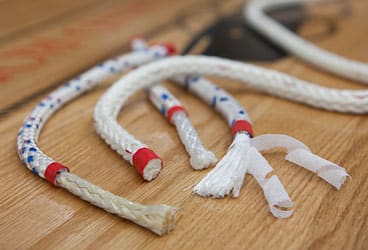
Replacing the running rigging on your sailboat seems like it should be fairly simple, and a decade or two ago, it was. As with electronics, safety gear, and even sails, technology has significantly improved cordage. The downside to all these improvements is that not only are there more options than ever, but you may feel like you need a materials-science degree in order to choose the right sailing ropes for your new jib halyard. Here, we’ll take a look at the types of sailing ropes and what the newer, high-tech materials can do for your boat.
When it comes time to choose new sailing rope for the lines aboard your boat, you’ll need to consider the type of sailing that you’ll be doing (a year in the tropics? racing to Bermuda?), the hardware that you currently have (clutches, sheaves), what qualities you feel are important (soft hand, ease in splicing, weight, durability), and your budget. The type of sails you have is another consideration. “If you’ve already made the investment in laminate sails, then you should really consider upgrading your running rigging to a low-stretch material,” says Brian Fisher of Rig Pro, in Portsmouth, Rhode Island. “But even if you have Dacron sails, you can benefit from a cordage upgrade.”
Starting at the top, you should check over your sheaves before replacing your halyards, and if you’re going from wire to rope halyards, you’ll need to change to rope sheaves. (Wire halyards use a V-shaped sheave; rope sheaves are U-shaped.) While you’re aloft, look for any sharp edges that could chafe through your new line, especially if you’re going from wire to rope halyards.
What’s the best halyard rope? There are plenty of choices for new halyards, from basic polyester double-braid to all the high-tech materials. Whatever you choose will probably be a compromise between such factors as amount of stretch, cost, weight, and ease of handling.
Long the workhorse on many a cruising boat, polyester (Dacron) double-braid is still a good choice for many onboard applications. Polyester is long lasting, resistant to ultraviolet radiation, and costs a fraction of high-tech rope; however, it’s somewhat stretchy and heavier than more modern materials, and if there’s one area on board that could benefit from an upgrade to lightweight low-stretch line, it’s the halyards.
Most cruising boats have a roller-furling headsail , and many have in-mast furling mainsails as well. Since these remain hoisted for possibly months at a time, a lightweight low-stretch line will offer better halyard tension and sail shape over the long run. This is true for non-roller-furling sails as well, especially if you’re heading out on a long passage where the sails will be set for a while. Here Fisher recommends using a Spectra/Dyneema-cored line, since it’s extremely strong, lightweight, and doesn’t absorb water. An alternative would be a Vectran-cored line, which stretches even less and doesn’t creep; however, it’s heavier than Spectra/Dyneema and absorbs water. When switching from polyester to a high-tech line, it’s usually possible to downsize the line by a few millimeters since these fibers are so strong. This is a definite advantage for bigger cruising boats, since polyester line can be quite bulky at larger diameters.
If the price tag of Spectra/Dyneema-cored or Vectran-cored line is a little steep, all the major rope manufacturers currently make “mid-level” blended-core ropes that would be well suited to the cruising environment (and easier on the wallet). A few examples are New England Ropes’ VPC, with a Vectran and polyolefin core, and T-900, with a Dyneema and Technora core; and Yale’s Vizzion, with a braided composite core of Vectran LCP and filament olefin.
Both high-tech lines and the mid-level blends typically have polyester covers, which provides extra UV protection and a nice hand, although there are also covers available that blend the polyester with materials such as Technora, for its abrasion-resistant and heat-dissipating qualities. If weight saving is a major issue aboard your boat, note that many of the high-tech ropes available are core dependent, and the cover can be stripped off. On the majority of cruising boats, however, the effect would be negligible.
Like halyards, sheets are an area where Spectra/Dyneema-cored lines can improve performance and even your sailing experience. “Since you can downsize your line when you switch from polyester, you end up with smaller, lighter piles in your cockpit and less weight pulling at your sail,” says Fisher. He offers an example of genoa halyards on an Oyster 46, which are 69 feet long. In this application, polyester double-braid lines would measure 3/4-inch in diameter, with a breaking strength of 16,000 pounds and a weight of 11 pounds. A Spectra/Dyneema-cored line would have a 1/2-inch diameter, a breaking strength of 20,000 pounds, and a weight of only 4.6 pounds. And only the polyester cover would absorb water, offering additional weight savings as well as more pleasant tacking.
It’s worth noting that if you’re replacing your running rigging, the time’s right to inspect your deck hardware, too. Since polyester line has more give, it absorbs more of the load from the sails. If you make the switch to high-tech line, be sure that your deck hardware is appropriately sized and reinforced.
Spinnaker sheets are well suited for a high-tech upgrade as well, since a lightweight, small-diameter line that’s also very strong will offer better performance. Examples of good choices for this application are Samson’s WarpSpeed, featuring a Dyneema core and a polyester cover, and New England Ropes’ Flight Line, which has a Dyneema core and a polypropylene cover.
Rope construction for the mainsheet is much a matter of personal preference. Single-braid is usually softer, has a nice hand, and doesn’t kink, but it could snag more than a double-braid line and doesn’t have the additional abrasion resistance of a cover. Yale Cordage’s Ph.D. rope is a single-braid construction made from polyester-coated Spectra. According to Yale, the polyester coating gives the rope a nice feel and good grip on winches, while the Spectra core gives it strength and weight savings.
All the Rest
While halyards and sheets have been the focus here, there are plenty of other places aboard that could benefit from a high-tech sailing rope makeover: runners, the outhaul, the traveler, the boom vang, even lifelines. If a major high-tech cordage upgrade is in your future, it may be wise to consult with a rigger to ensure that the chosen material is suitable to the application on your particular boat and that your lines are appropriately sized. “I’ve seen several situations in which customers have forgotten to take into account proper line size with regard to the winches and rope clutches on their boats,” notes Andrew Spiro of The Ship’s Store and Rigging, in Portsmouth, Rhode Island. “It’s simple, but just because you can use a smaller-diameter line with the same strength, they forget that the winches and clutches are limited to certain sizes. The result is often slipping.”
Always on the forefront of technology, raceboats have been using high-tech fibers for years in many applications on board, even standing rigging, and as these fibers have improved and their acceptance has grown, more and more wire is being traded out in favor of these lightweight alternatives. Cruisers can also reap benefit from these advances.
Jen Brett is CW’s senior editor.
Rope Guide for Sailboats
Aramids (Twaron, Technora, Kevlar): Like other high-tech fibers, aramids are strong and stretch little, but they also have the benefit of being resistant to heat. You’ll find aramids in both double-braid cores as well as blended with other fibers in the covers.
Colligo Dux: A relative newcomer to sailboat rigging, Colligo Dux is pre-stretched and heat-treated Dyneema. This process, however, produces an extremely strong rope with virtually no creep that is suitable for service in standing rigging.
H.M.P.E. (Dyneema, Spectra, Amsteel): High-modulus polyethylene has many benefits for running-rigging applications: It’s very strong, lightweight, doesn’t absorb water, has decent resistance to ultraviolet radiation, and it can float. On the downside, it has more creep (see “Rope Speak,” page 80) than other high-tech fibers.
L.C.P. (Vectran): Liquid-crystal polymer fiber possesses high-strength and low-stretch qualities and suffers virtually no creep. L.C.P. is one of the strongest core materials, although it doesn’t have the U.V. resistance of H.M.P.E., and it’s a little bit heavier.
Nylon: Strong yet stretchy nylon is commonly used in applications for which shock absorption is important, such as in dock lines and anchor lines.
P.B.O. (Zylon): Polybenzoxazole is extremely low stretch and high strength. It’s also ungodly expensive and lacks the durability that most cruisers desire. As such, P.B.O. is usually only found on high-end raceboats.
Polyester (Dacron): For decades, polyester has been the go-to rope for cruising-boat halyards and sheets. It’s cost efficient, strong, and resists ultraviolet radiation.
Polypropylene: Usually used in applications like ski and dinghy tow ropes, polypropylene is lightweight and can float. Alone, polypropylene isn’t usually seen in cruising-boat lines since it’s very susceptible to UV degradation, but it’s sometimes combined with other fibers that benefit from its lightweight, low-cost qualities.
- More: DIY Sailboat Projects , Gear , How To , sail handling , sails & rigging , sails and rigging
- More How To

3 Clutch Sails For Peak Performance

It’s Time to Rethink Your Ditch Kit

8 Ways to Prevent Seasickness

How To De-Winterize Your Diesel Engine

Kirsten Neuschäfer Receives CCA Blue Water Medal

2024 Regata del Sol al Sol Registration Closing Soon

US Sailing Honors Bob Johnstone

Bitter End Expands Watersports Program
- Digital Edition
- Customer Service
- Privacy Policy
- Email Newsletters
- Cruising World
- Sailing World
- Salt Water Sportsman
- Sport Fishing
- Wakeboarding

Beginner’s Guide: How To Rig A Sailboat – Step By Step Tutorial
Alex Morgan
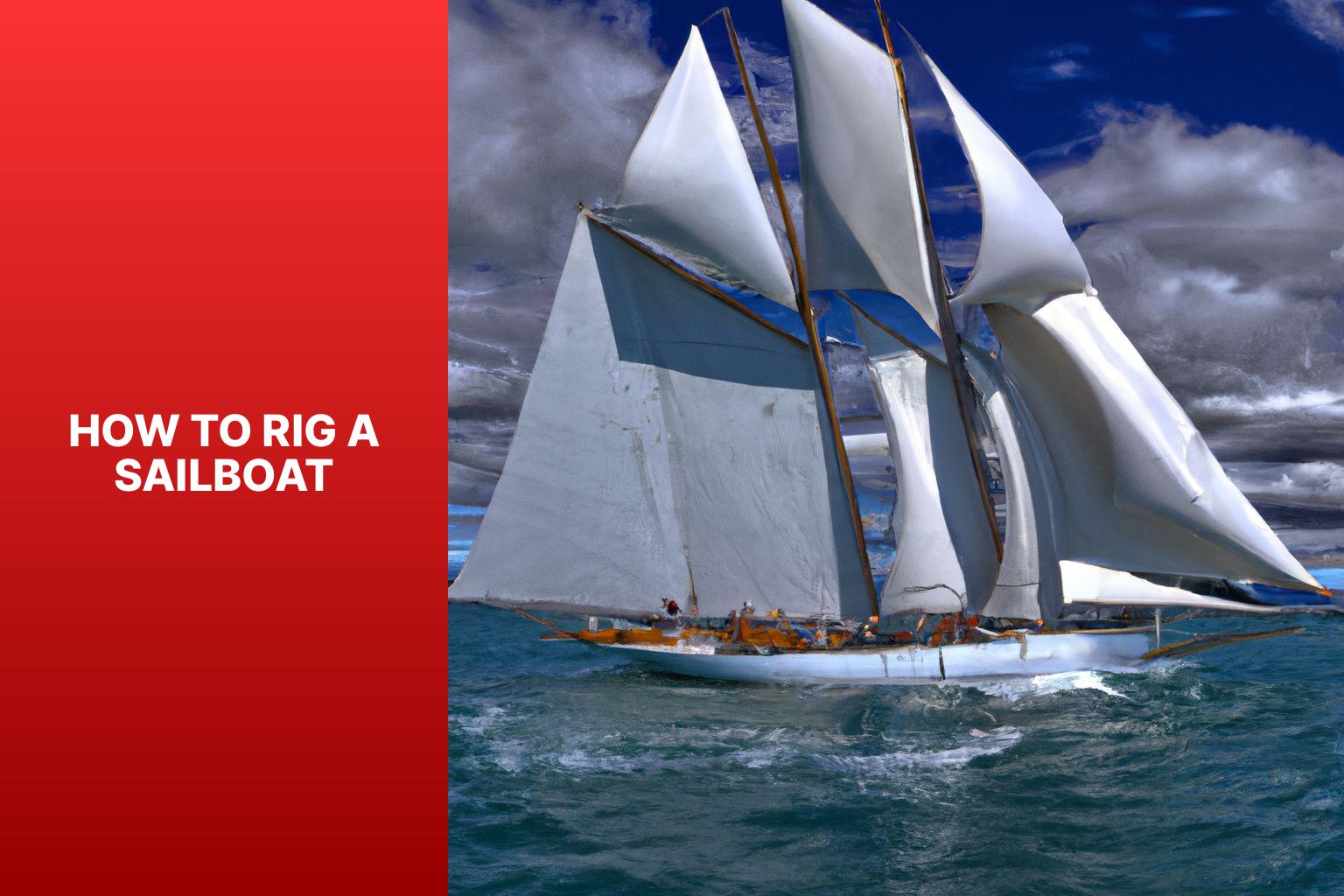
Rigging a sailboat is a crucial process that ensures the proper setup and functioning of a sailboat’s various components. Understanding the process and components involved in rigging is essential for any sailor or boat enthusiast. In this article, we will provide a comprehensive guide on how to rig a sailboat.
Introduction to Rigging a Sailboat
Rigging a sailboat refers to the process of setting up the components that enable the sailboat to navigate through the water using wind power. This includes assembling and positioning various parts such as the mast, boom, standing rigging, running rigging, and sails.
Understanding the Components of a Sailboat Rigging
Before diving into the rigging process, it is important to have a good understanding of the key components involved. These components include:
The mast is the tall vertical spar that provides vertical support to the sails and holds them in place.
The boom is the horizontal spar that runs along the bottom edge of the sail and helps control the shape and position of the sail.
- Standing Rigging:
Standing rigging consists of the wires and cables that support and stabilize the mast, keeping it upright.
- Running Rigging:
Running rigging refers to the lines and ropes used to control the sails, such as halyards, sheets, and control lines.
Preparing to Rig a Sailboat
Before rigging a sailboat, there are a few important steps to take. These include:
- Checking the Weather Conditions:
It is crucial to assess the weather conditions before rigging a sailboat. Unfavorable weather, such as high winds or storms, can make rigging unsafe.
- Gathering the Necessary Tools and Equipment:
Make sure to have all the necessary tools and equipment readily available before starting the rigging process. This may include wrenches, hammers, tape, and other common tools.
- Inspecting the Rigging Components:
In the upcoming sections of this article, we will provide a step-by-step guide on how to rig a sailboat, as well as important safety considerations and tips to keep in mind. By following these guidelines, you will be able to rig your sailboat correctly and safely, allowing for a smooth and enjoyable sailing experience.
Key takeaway:
- Rigging a sailboat maximizes efficiency: Proper rigging allows for optimized sailing performance, ensuring the boat moves smoothly through the water.
- Understanding sailboat rigging components: Familiarity with the various parts of a sailboat rigging, such as the mast, boom, and standing and running riggings, is essential for effective rigging setup.
- Importance of safety in sailboat rigging: Ensuring safety is crucial during the rigging process, including wearing a personal flotation device, securing loose ends and lines, and being mindful of overhead power lines.
Get ready to set sail and dive into the fascinating world of sailboat rigging! We’ll embark on a journey to understand the various components that make up a sailboat’s rigging. From the majestic mast to the nimble boom , and the intricate standing rigging to the dynamic running rigging , we’ll explore the crucial elements that ensure smooth sailing. Not forgetting the magnificent sail, which catches the wind and propels us forward. So grab your sea legs and let’s uncover the secrets of sailboat rigging together.
Understanding the mast is crucial when rigging a sailboat. Here are the key components and steps to consider:
1. The mast supports the sails and rigging of the sailboat. It is made of aluminum or carbon fiber .
2. Before stepping the mast , ensure that the area is clear and the boat is stable. Have all necessary tools and equipment ready.
3. Inspect the mast for damage or wear. Check for corrosion , loose fittings , and cracks . Address any issues before proceeding.
4. To step the mast , carefully lift it into an upright position and insert the base into the mast step on the deck of the sailboat.
5. Secure the mast using the appropriate rigging and fasteners . Attach the standing rigging , such as shrouds and stays , to the mast and the boat’s hull .
Fact: The mast of a sailboat is designed to withstand wind resistance and the tension of the rigging for stability and safe sailing.
The boom is an essential part of sailboat rigging. It is a horizontal spar that stretches from the mast to the aft of the boat. Constructed with durable yet lightweight materials like aluminum or carbon fiber, the boom provides crucial support and has control over the shape and position of the sail. It is connected to the mast through a boom gooseneck , allowing it to pivot. One end of the boom is attached to the mainsail, while the other end is equipped with a boom vang or kicker, which manages the tension and angle of the boom. When the sail is raised, the boom is also lifted and positioned horizontally by using the topping lift or lazy jacks.
An incident serves as a warning that emphasizes the significance of properly securing the boom. In strong winds, an improperly fastened boom swung across the deck, resulting in damage to the boat and creating a safety hazard. This incident highlights the importance of correctly installing and securely fastening all rigging components, including the boom, to prevent accidents and damage.
3. Standing Rigging
When rigging a sailboat, the standing rigging plays a vital role in providing stability and support to the mast . It consists of several key components, including the mast itself, along with the shrouds , forestay , backstay , and intermediate shrouds .
The mast, a vertical pole , acts as the primary support structure for the sails and the standing rigging. Connected to the top of the mast are the shrouds , which are cables or wires that extend to the sides of the boat, providing essential lateral support .
The forestay is another vital piece of the standing rigging. It is a cable or wire that runs from the top of the mast to the bow of the boat, ensuring forward support . Similarly, the backstay , also a cable or wire, runs from the mast’s top to the stern of the boat, providing important backward support .
To further enhance the rig’s stability , intermediate shrouds are installed. These additional cables or wires are positioned between the main shrouds, as well as the forestay or backstay. They offer extra support , strengthening the standing rigging system.
Regular inspections of the standing rigging are essential to detect any signs of wear, such as fraying or corrosion . It is crucial to ensure that all connections within the rig are tight and secure, to uphold its integrity. Should any issues be identified, immediate attention must be given to prevent accidents or damage to the boat. Prioritizing safety is of utmost importance when rigging a sailboat, thereby necessitating proper maintenance of the standing rigging. This ensures a safe and enjoyable sailing experience.
Note: <p> tags have been kept intact.
4. Running Rigging
Running Rigging
When rigging a sailboat, the running rigging is essential for controlling the sails and adjusting their position. It is important to consider several aspects when dealing with the running rigging.
1. Choose the right rope: The running rigging typically consists of ropes with varying properties such as strength, stretch, and durability. Weather conditions and sailboat size should be considered when selecting the appropriate rope.
2. Inspect and maintain the running rigging: Regularly check for signs of wear, fraying, or damage. To ensure safety and efficiency, replace worn-out ropes.
3. Learn essential knot tying techniques: Having knowledge of knots like the bowline, cleat hitch, and reef knot is crucial for securing the running rigging and adjusting sails.
4. Understand different controls: The running rigging includes controls such as halyards, sheets, and control lines. Familiarize yourself with their functions and proper usage to effectively control sail position and tension.
5. Practice proper sail trimming: Adjusting the tension of the running rigging significantly affects sailboat performance. Mastering sail trimming techniques will help optimize sail shape and maximize speed.
By considering these factors and mastering running rigging techniques, you can enhance your sailing experience and ensure the safe operation of your sailboat.
The sail is the central component of sailboat rigging as it effectively harnesses the power of the wind to propel the boat.
When considering the sail, there are several key aspects to keep in mind:
– Material: Sails are typically constructed from durable and lightweight materials such as Dacron or polyester. These materials provide strength and resistance to various weather conditions.
– Shape: The shape of the sail plays a critical role in its overall performance. A well-shaped sail should have a smooth and aerodynamic profile, which allows for maximum efficiency in capturing wind power.
– Size: The size of the sail is determined by its sail area, which is measured in square feet or square meters. Larger sails have the ability to generate more power, but they require greater skill and experience to handle effectively.
– Reefing: Reefing is the process of reducing the sail’s size to adapt to strong winds. Sails equipped with reefing points allow sailors to decrease the sail area, providing better control in challenging weather conditions.
– Types: There are various types of sails, each specifically designed for different purposes. Common sail types include mainsails, jibs, genoas, spinnakers, and storm sails. Each type possesses its own unique characteristics and is utilized under specific wind conditions.
Understanding the sail and its characteristics is vital for sailors, as it directly influences the boat’s speed, maneuverability, and overall safety on the water.
Getting ready to rig a sailboat requires careful preparation and attention to detail. In this section, we’ll dive into the essential steps you need to take before setting sail. From checking the weather conditions to gathering the necessary tools and equipment, and inspecting the rigging components, we’ll ensure that you’re fully equipped to navigate the open waters with confidence. So, let’s get started on our journey to successfully rigging a sailboat!
1. Checking the Weather Conditions
Checking the weather conditions is crucial before rigging a sailboat for a safe and enjoyable sailing experience. Monitoring the wind speed is important in order to assess the ideal sailing conditions . By checking the wind speed forecast , you can determine if the wind is strong or light . Strong winds can make sailboat control difficult, while very light winds can result in slow progress.
Another important factor to consider is the wind direction . Assessing the wind direction is crucial for route planning and sail adjustment. Favorable wind direction helps propel the sailboat efficiently, making your sailing experience more enjoyable.
In addition to wind speed and direction, it is also important to consider weather patterns . Keep an eye out for impending storms or heavy rain. It is best to avoid sailing in severe weather conditions that may pose a safety risk. Safety should always be a top priority when venturing out on a sailboat.
Another aspect to consider is visibility . Ensure good visibility by checking for fog, haze, or any other conditions that may hinder navigation. Clear visibility is important for being aware of other boats and potential obstacles that may come your way.
Be aware of the local conditions . Take into account factors such as sea breezes, coastal influences, or tidal currents. These local factors greatly affect sailboat performance and safety. By considering all of these elements, you can have a successful and enjoyable sailing experience.
Here’s a true story to emphasize the importance of checking the weather conditions. One sunny afternoon, a group of friends decided to go sailing. Before heading out, they took the time to check the weather conditions. They noticed that the wind speed was expected to be around 10 knots, which was perfect for their sailboat. The wind direction was coming from the northwest, allowing for a pleasant upwind journey. With clear visibility and no approaching storms, they set out confidently, enjoying a smooth and exhilarating sail. This positive experience was made possible by their careful attention to checking the weather conditions beforehand.
2. Gathering the Necessary Tools and Equipment
To efficiently gather all of the necessary tools and equipment for rigging a sailboat, follow these simple steps:
- First and foremost, carefully inspect your toolbox to ensure that you have all of the basic tools such as wrenches, screwdrivers, and pliers.
- Make sure to check if you have a tape measure or ruler available as they are essential for precise measurements of ropes or cables.
- Don’t forget to include a sharp knife or rope cutter in your arsenal as they will come in handy for cutting ropes or cables to the desired lengths.
- Gather all the required rigging hardware including shackles, pulleys, cleats, and turnbuckles.
- It is always prudent to check for spare ropes or cables in case replacements are needed during the rigging process.
- If needed, consider having a sailing knife or marlinspike tool for splicing ropes or cables.
- For rigging a larger sailboat, it is crucial to have a mast crane or hoist to assist with stepping the mast.
- Ensure that you have a ladder or some other means of reaching higher parts of the sailboat, such as the top of the mast.
Once, during the preparation of rigging my sailboat, I had a moment of realization when I discovered that I had forgotten to bring a screwdriver . This unfortunate predicament occurred while I was in a remote location with no nearby stores. Being resourceful, I improvised by utilizing a multipurpose tool with a small knife blade, which served as a makeshift screwdriver. Although it was not the ideal solution, it allowed me to accomplish the task. Since that incident, I have learned the importance of double-checking my toolbox before commencing any rigging endeavor. This practice ensures that I have all of the necessary tools and equipment, preventing any unexpected surprises along the way.
3. Inspecting the Rigging Components
Inspecting the rigging components is essential for rigging a sailboat safely. Here is a step-by-step guide on inspecting the rigging components:
1. Visually inspect the mast, boom, and standing rigging for damage, such as corrosion, cracks, or loose fittings.
2. Check the tension of the standing rigging using a tension gauge. It should be within the recommended range from the manufacturer.
3. Examine the turnbuckles, clevis pins, and shackles for wear or deformation. Replace any damaged or worn-out hardware.
4. Inspect the running rigging, including halyards and sheets, for fraying, signs of wear, or weak spots. Replace any worn-out lines.
5. Check the sail for tears, wear, or missing hardware such as grommets or luff tape.
6. Pay attention to the connections between the standing rigging and the mast. Ensure secure connections without any loose or missing cotter pins or rigging screws.
7. Inspect all fittings, such as mast steps, spreader brackets, and tangs, to ensure they are securely fastened and in good condition.
8. Conduct a sea trial to assess the rigging’s performance and make necessary adjustments.
Regularly inspecting the rigging components is crucial for maintaining the sailboat’s rigging system’s integrity, ensuring safe sailing conditions, and preventing accidents or failures at sea.
Once, I went sailing on a friend’s boat without inspecting the rigging components beforehand. While at sea, a sudden gust of wind caused one of the shrouds to snap. Fortunately, no one was hurt, but we had to cut the sail loose and carefully return to the marina. This incident taught me the importance of inspecting the rigging components before sailing to avoid unforeseen dangers.
Step-by-Step Guide on How to Rig a Sailboat
Get ready to set sail with our step-by-step guide on rigging a sailboat ! We’ll take you through the process from start to finish, covering everything from stepping the mast to setting up the running rigging . Learn the essential techniques and tips for each sub-section, including attaching the standing rigging and installing the boom and sails . Whether you’re a seasoned sailor or a beginner, this guide will have you ready to navigate the open waters with confidence .
1. Stepping the Mast
To step the mast of a sailboat, follow these steps:
1. Prepare the mast: Position the mast near the base of the boat.
2. Attach the base plate: Securely fasten the base plate to the designated area on the boat.
3. Insert the mast step: Lower the mast step into the base plate and align it with the holes or slots.
4. Secure the mast step: Use fastening screws or bolts to fix the mast step in place.
5. Raise the mast: Lift the mast upright with the help of one or more crew members.
6. Align the mast: Adjust the mast so that it is straight and aligned with the boat’s centerline.
7. Attach the shrouds: Connect the shrouds to the upper section of the mast, ensuring proper tension.
8. Secure the forestay: Attach the forestay to the bow of the boat, ensuring it is securely fastened.
9. Final adjustments: Check the tension of the shrouds and forestay, making any necessary rigging adjustments.
Following these steps ensures that the mast is properly stepped and securely in place, allowing for a safe and efficient rigging process. Always prioritize safety precautions and follow manufacturer guidelines for your specific sailboat model.
2. Attaching the Standing Rigging
To attach the standing rigging on a sailboat, commence by preparing the essential tools and equipment, including wire cutters, crimping tools, and turnbuckles.
Next, carefully inspect the standing rigging components for any indications of wear or damage.
After inspection, fasten the bottom ends of the shrouds and stays to the chainplates on the deck.
Then, securely affix the top ends of the shrouds and stays to the mast using adjustable turnbuckles .
To ensure proper tension, adjust the turnbuckles accordingly until the mast is upright and centered.
Utilize a tension gauge to measure the tension in the standing rigging, aiming for around 15-20% of the breaking strength of the rigging wire.
Double-check all connections and fittings to verify their security and proper tightness.
It is crucial to regularly inspect the standing rigging for any signs of wear or fatigue and make any necessary adjustments or replacements.
By diligently following these steps, you can effectively attach the standing rigging on your sailboat, ensuring its stability and safety while on the water.
3. Installing the Boom and Sails
To successfully complete the installation of the boom and sails on a sailboat, follow these steps:
1. Begin by securely attaching the boom to the mast. Slide it into the gooseneck fitting and ensure it is firmly fastened using a boom vang or another appropriate mechanism.
2. Next, attach the main sail to the boom. Slide the luff of the sail into the mast track and securely fix it in place using sail slides or cars.
3. Connect the mainsheet to the boom. One end should be attached to the boom while the other end is connected to a block or cleat on the boat.
4. Proceed to attach the jib or genoa. Make sure to securely attach the hanks or furler line to the forestay to ensure stability.
5. Connect the jib sheets. One end of each jib sheet should be attached to the clew of the jib or genoa, while the other end is connected to a block or winch on the boat.
6. Before setting sail, it is essential to thoroughly inspect all lines and connections. Ensure that they are properly tensioned and that all connections are securely fastened.
During my own experience of installing the boom and sails on my sailboat, I unexpectedly encountered a strong gust of wind. As a result, the boom began swinging uncontrollably, requiring me to quickly secure it to prevent any damage. This particular incident served as a vital reminder of the significance of properly attaching and securing the boom, as well as the importance of being prepared for unforeseen weather conditions while rigging a sailboat.
4. Setting Up the Running Rigging
Setting up the running rigging on a sailboat involves several important steps. First, attach the halyard securely to the head of the sail. Then, connect the sheets to the clew of the sail. If necessary, make sure to secure the reefing lines . Attach the outhaul line to the clew of the sail and connect the downhaul line to the tack of the sail. It is crucial to ensure that all lines are properly cleated and organized. Take a moment to double-check the tension and alignment of each line. If you are using a roller furling system, carefully wrap the line around the furling drum and securely fasten it. Perform a thorough visual inspection of the running rigging to check for any signs of wear or damage. Properly setting up the running rigging is essential for safe and efficient sailing. It allows for precise control of the sail’s position and shape, ultimately optimizing the boat’s performance on the water.
Safety Considerations and Tips
When it comes to rigging a sailboat, safety should always be our top priority. In this section, we’ll explore essential safety considerations and share some valuable tips to ensure smooth sailing. From the importance of wearing a personal flotation device to securing loose ends and lines, and being cautious around overhead power lines, we’ll equip you with the knowledge and awareness needed for a safe and enjoyable sailing experience. So, let’s set sail and dive into the world of safety on the water!
1. Always Wear a Personal Flotation Device
When rigging a sailboat, it is crucial to prioritize safety and always wear a personal flotation device ( PFD ). Follow these steps to properly use a PFD:
- Select the appropriate Coast Guard-approved PFD that fits your size and weight.
- Put on the PFD correctly by placing your arms through the armholes and securing all the straps for a snug fit .
- Adjust the PFD for comfort , ensuring it is neither too tight nor too loose, allowing freedom of movement and adequate buoyancy .
- Regularly inspect the PFD for any signs of wear or damage, such as tears or broken straps, and replace any damaged PFDs immediately .
- Always wear your PFD when on or near the water, even if you are a strong swimmer .
By always wearing a personal flotation device and following these steps, you will ensure your safety and reduce the risk of accidents while rigging a sailboat. Remember, prioritize safety when enjoying water activities.
2. Secure Loose Ends and Lines
Inspect lines and ropes for frayed or damaged areas. Secure loose ends and lines with knots or appropriate cleats or clamps. Ensure all lines are properly tensioned to prevent loosening during sailing. Double-check all connections and attachments for security. Use additional safety measures like extra knots or stopper knots to prevent line slippage.
To ensure a safe sailing experience , it is crucial to secure loose ends and lines properly . Neglecting this important step can lead to accidents or damage to the sailboat. By inspecting, securing, and tensioning lines , you can have peace of mind knowing that everything is in place. Replace or repair any compromised lines or ropes promptly. Securing loose ends and lines allows for worry-free sailing trips .
3. Be Mindful of Overhead Power Lines
When rigging a sailboat, it is crucial to be mindful of overhead power lines for safety. It is important to survey the area for power lines before rigging the sailboat. Maintain a safe distance of at least 10 feet from power lines. It is crucial to avoid hoisting tall masts or long antenna systems near power lines to prevent contact. Lower the mast and tall structures when passing under a power line to minimize the risk of contact. It is also essential to be cautious in areas where power lines run over the water and steer clear to prevent accidents.
A true story emphasizes the importance of being mindful of overhead power lines. In this case, a group of sailors disregarded safety precautions and their sailboat’s mast made contact with a low-hanging power line, resulting in a dangerous electrical shock. Fortunately, no serious injuries occurred, but it serves as a stark reminder of the need to be aware of power lines while rigging a sailboat.
Some Facts About How To Rig A Sailboat:
- ✅ Small sailboat rigging projects can improve sailing performance and save money. (Source: stingysailor.com)
- ✅ Rigging guides are available for small sailboats, providing instructions and tips for rigging. (Source: westcoastsailing.net)
- ✅ Running rigging includes lines used to control and trim the sails, such as halyards and sheets. (Source: sailingellidah.com)
- ✅ Hardware used in sailboat rigging includes winches, blocks, and furling systems. (Source: sailingellidah.com)
- ✅ A step-by-step guide can help beginners rig a small sailboat for sailing. (Source: tripsavvy.com)
Frequently Asked Questions
1. how do i rig a small sailboat.
To rig a small sailboat, follow these steps: – Install or check the rudder, ensuring it is firmly attached. – Attach or check the tiller, the long steering arm mounted to the rudder. – Attach the jib halyard by connecting the halyard shackle to the head of the sail and the grommet in the tack to the bottom of the forestay. – Hank on the jib by attaching the hanks of the sail to the forestay one at a time. – Run the jib sheets by tying or shackling them to the clew of the sail and running them back to the cockpit. – Attach the mainsail by spreading it out and attaching the halyard shackle to the head of the sail. – Secure the tack, clew, and foot of the mainsail to the boom using various lines and mechanisms. – Insert the mainsail slugs into the mast groove, gradually raising the mainsail as the slugs are inserted. – Cleat the main halyard and lower the centerboard into the water. – Raise the jib by pulling down on the jib halyard and cleating it on the other side of the mast. – Tighten the mainsheet and one jibsheet to adjust the sails and start moving forward.
2. What are the different types of sailboat rigs?
Sailboat rigs can be classified into three main types: – Sloop rig: This rig has a single mast with a mainsail and a headsail, typically a jib or genoa. – Cutter rig: This rig has two headsails, a smaller jib or staysail closer to the mast, and a larger headsail, usually a genoa, forward of it, alongside a mainsail. – Ketch rig: This rig has two masts, with the main mast taller than the mizzen mast. It usually has a mainsail, headsail, and a mizzen sail. Each rig has distinct characteristics and is suitable for different sailing conditions and preferences.
3. What are the essential parts of a sailboat?
The essential parts of a sailboat include: – Mast: The tall vertical spar that supports the sails. – Boom: The horizontal spar connected to the mast, which extends outward and supports the foot of the mainsail. – Rudder: The underwater appendage that steers the boat. – Centerboard or keel: A retractable or fixed fin-like structure that provides stability and prevents sideways drift. – Sails: The fabric structures that capture the wind’s energy to propel the boat. – Running rigging: The lines or ropes used to control the sails and sailing equipment. – Standing rigging: The wires and cables that support the mast and reinforce the spars. These are the basic components necessary for the functioning of a sailboat.
4. What is a spinnaker halyard?
A spinnaker halyard is a line used to hoist and control a spinnaker sail. The spinnaker is a large, lightweight sail that is used for downwind sailing or reaching in moderate to strong winds. The halyard attaches to the head of the spinnaker and is used to raise it to the top of the mast. Once hoisted, the spinnaker halyard can be adjusted to control the tension and shape of the sail.
5. Why is it important to maintain and replace worn running rigging?
It is important to maintain and replace worn running rigging for several reasons: – Safety: Worn or damaged rigging can compromise the integrity and stability of the boat, posing a safety risk to both crew and vessel. – Performance: Worn rigging can affect the efficiency and performance of the sails, diminishing the boat’s speed and maneuverability. – Reliability: Aging or worn rigging is more prone to failure, which can lead to unexpected problems and breakdowns. Regular inspection and replacement of worn running rigging is essential to ensure the safe and efficient operation of a sailboat.
6. Where can I find sailboat rigging books or guides?
There are several sources where you can find sailboat rigging books or guides: – Online: Websites such as West Coast Sailing and Stingy Sailor offer downloadable rigging guides for different sailboat models. – Bookstores: Many bookstores carry a wide selection of boating and sailing books, including those specifically focused on sailboat rigging. – Sailing schools and clubs: Local sailing schools or yacht clubs often have resources available for learning about sailboat rigging. – Manufacturers: Some sailboat manufacturers, like Hobie Cat and RS Sailing, provide rigging guides for their specific sailboat models. Consulting these resources can provide valuable information and instructions for rigging your sailboat properly.
About the author
Leave a Reply Cancel reply
Your email address will not be published. Required fields are marked *
Save my name, email, and website in this browser for the next time I comment.
Latest posts

The history of sailing – from ancient times to modern adventures
History of Sailing Sailing is a time-honored tradition that has evolved over millennia, from its humble beginnings as a means of transportation to a beloved modern-day recreational activity. The history of sailing is a fascinating journey that spans cultures and centuries, rich in innovation and adventure. In this article, we’ll explore the remarkable evolution of…

Sailing Solo: Adventures and Challenges of Single-Handed Sailing
Solo Sailing Sailing has always been a pursuit of freedom, adventure, and self-discovery. While sailing with a crew is a fantastic experience, there’s a unique allure to sailing solo – just you, the wind, and the open sea. Single-handed sailing, as it’s often called, is a journey of self-reliance, resilience, and the ultimate test of…

Sustainable Sailing: Eco-Friendly Practices on the boat
Eco Friendly Sailing Sailing is an exhilarating and timeless way to explore the beauty of the open water, but it’s important to remember that our oceans and environment need our protection. Sustainable sailing, which involves eco-friendly practices and mindful decision-making, allows sailors to enjoy their adventures while minimizing their impact on the environment. In this…
JIB FURLING GEAR
- CDI Flexible
- Furling Accessories
- Racing Foils
- Whisker and Spinnaker
MAIN SAIL FURLING and REEFING
- Boom Furlers
- Reefing and LazyJacks
MAIN SAIL TRACK SYSTEMS
Standing rigging.
- Swage Terminals and Toggles
- Turnbuckles
- Backstay Adjusters
- Inner Forestay Tools...
- Miscellaneous Hardware
- Measuring Guide
- Hardware and Wire
RUNNING RIGGING
- Rope Clutches
- Cam and Standard Cleats
- Pad Eyes, Eye Straps
- Rachet, Snatch, Wire
- Halyard Lift
- Accessories
- rigid vangs
- tackle vangs
GROUND TACKLE
Mast climbing.
- ATN Top Climber
RADAR MOUNTS AND REFLECTORS
Welcome to rigging only.
Our www.riggingandhardware.com shop on line site is now open for business. We now have most manufacture's parts up and running. Pricing is current on the riggingandhardware.com site. Pictures and selection guides are rather lacking at this time but we are working on them and will be loading more product and manufacturers asap. As always, don't hesitate to contact us with any questions or to place an order at [email protected] or call (508) 992-0434.

Our Mission
- We now stock and swage wire up to 5/8 diameter for sailboat standing rigging and architectural wire projects. Larger sizes are available.
- We now stock and swage wire up to 5/8 diameter for standing rigging and architectural projects. Larger sizes are available.
- Metric wire and swage fittings are available for standing rigging applications. We are able to provide swaged standing rigging assemblies as well as mechanical terminals (assembled or you assemble) to meet your needs at an affordable cost. Current stock is 8-10-12mm. Note the bulk of these fittings will have imperial pin and thread dimensions.
Return Policy
Customer comments.
- We thank you and your staff for your help and advise. We are enjoying sailing more with the furler. M.&R. G., Chicago
- All arrived safely and perfectly on time. The lifelines are almost too pretty to put on the boat and it's a damn pretty boat. The shrouds and backstay are superb and a perfect fit. If anyone ever wants a referral about Rigging Only tell them to contact me. R. A. , Curator, N. C.
- Just a quick note to tell you how grateful I am. The order was waiting for me when I arrived as promised. All the parts were of top quality and the prices were more than reasonable. I am recommending the services and products of Rigging Only to all my fellow charter captains of the Virgin Islands Charter League. Capt. G. F. USVI
- Due to your excellent quality, service, and prices on my previous order I would like to get a price quote and estimated turnaround time for replacing my current standing rigging... B. S. Gurnee, IL.
- Got them on time! Many Thanks! C. S. Lacombe, LA
Contact Information

- Lines & Rigging
Sailboat Running Rigging
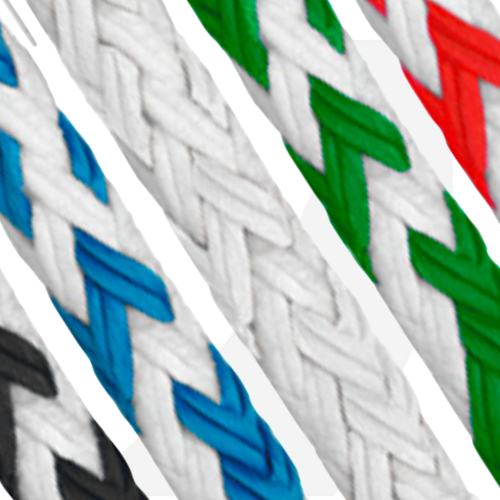
Sea Sure Felco C112 Wire Cutter

Sea Sure Handle & Head-2/2.5/3/4mm Copper/Ali

Sea Sure Felco C16 Wire Cutter

Sea Sure Handles & Head-2.5mm Copper & Aluminium

Sea Sure Handles & Head-3mm Copper & Aluminium

Sea Sure Handles & Head-4mm Copper & Aluminium

Sea Sure Handles & Head-5mm Copper & Aluminium

Sea Sure Handles & Spare Head-6mm Copper Ferrules

Sea Sure Handles with Head-1mm Copper Ferrules

Sea Sure Handles with Head-2mm Copper & Aluminium

Sea Sure Felco C108 Wire Cutters

Sea Sure Small Hand Tool / 2mm & 2.5mm - 32-VC-VG
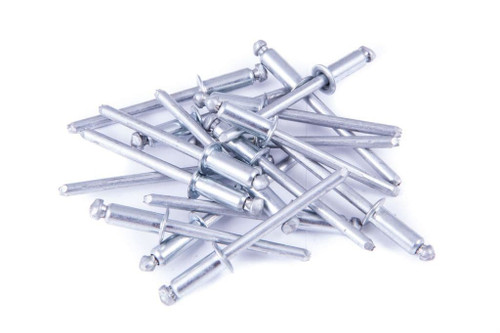
Sea Sure 1/4"x3/4" Monel Pop Rivet - TLP/D/870BS

Sea Sure Felco C12 Wire Cutter

Sea Sure 1/4"x1/2" Monel Pop Rivet - TLP/D/850BS

Sea Sure 3/16"x3/4" Monel Pop Rivet - TLP/D/675BS

Sea Sure Long Arm Pop Rivet Gun Spiralux

Sea Sure 3/16"x5/8" Monel Pop Rivet - TLP/D/665

Sea Sure Felco C9 Wire Cutter

Sea Sure 3/16"x1/2" Monel Pop Rivet - TLP/D/650BS
× You are using an outdated browser. Please upgrade your browser to improve your experience.
We Ship Worldwide! | FREE SHIPPING! for US Continental orders over $99. Click for details.

Shopping Cart
Your cart is currently empty..
FREE SHIPPING! for US Continental orders over $99 click for details
Sailboat Running Rigging

Running Rigging components include all hardware necessary to construct halyards, sheets and control lines for your sailboat like halyard shackles, shackle guards, spool shackles, thimbles and splicing services.
We at MAURIPRO Sailing are fully committed to being your Sailboat Running Rigging specialist not only providing the sailing community with a comprehensive and easy-to-use website, but also with all the appropriate technical information that you might need to select your sailboat hardware and equipment.
MAURIPRO Sailing, your direct access to Sailboat Running Rigging and all your other sailing and boating needs.
Copyright © 2024 MAURIPRO Sailing LLC.
JavaScript seems to be disabled in your browser. For the best experience on our site, be sure to turn on Javascript in your browser.
- Sign In Sign In .options", "triggerTarget":"#authorization-trigger", "closeOnMouseLeave": false, "triggerClass":"active", "parentClass":"active", "buttons":null}}'> Email --> Password --> Login Sign up --> Forgot Your Password?
- Create an Account

- Marine Rope
- Dyneema Rope
Running Rigging
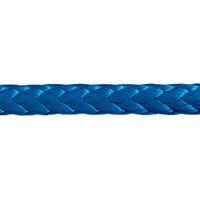
- Club Racing 5 item
- Cruising 3 item
- Racing 2 item
- $0.00 - $0.99 8 item
- $1.00 and above 1 item
- FSE Robline 1 item
- New England Ropes 3 item
- Samson 5 item
- Remove This Item

IMAGES
VIDEO
COMMENTS
By Robin Iversen January 12, 2024. The running rigging on a sailboat consists of all the lines used to hoist, lower, and control the sails and sailing equipment. These lines usually have different colors and patterns to easily identify their function and location on the vessel. Looking at the spaghetti of lines with different colors and ...
Our running rigging calculator can instantly spec lines for more than 5,000 sailboats. Just select your boat below and you're a couple clicks away from new, top quality rigging. We've reduced the choices to a minimum to make ordering as simple as possible. (If you prefer more choices, please see our Running Rigging Builder.)
Understanding the Importance of Sailboat Running Rigging. Before we delve into the nitty-gritty of line selection, it's crucial to understand the significance of running rigging. These lines are responsible for controlling the sails and the overall performance of your sailboat. Each line has its specific purpose, be it controlling the main sail ...
Polyester double braid works great for frequently adjusted lines, like main and jib sheets, or moderately loaded control lines. It is very flexible and easy to handle, and is still the line of choice for most applications on cruisers and club racers. Specific Gravity is 1.38, so it does not float.
Understanding Running Rigging. Standing rigging keeps the mast in place, but it's the running rigging that handles all the action aboard a boat under sail. The many components in a modern running rigging system—sheets, outhauls, vang control, halyards—work in conjunction with wide range of blocks to keep friction to a minimum. Ralph ...
Short answer running rigging on a sailboat: Running rigging refers to the ropes and lines used for controlling the sails and other movable parts on a sailboat. It includes halyards, sheets, braces, and control lines. Properly rigged running rigging is essential for efficient sail handling and maneuvering of the boat. Understanding Running Rigging on a
Short answer running rigging for sailboats: Running rigging refers to the set of lines or ropes used to control the sails on a sailboat. It includes halyards, sheets, and control lines that regulate sail positioning, trim, and hoisting. These essential components are crucial for maneuverability and sail adjustment during sailing. Introduction to Running Rigging for
Pro Tip No. 3: Minimizing the last purchase of an outhaul greatly increases the ease with which it can be pulled on or eased out. For example, you could have a 6-to-1 to one pulling a 2-to-1 ...
When it comes to making running rigging aboard sailboats, laid rope takes a back seat to braided line. The 26 samples of rope we evaluated for this test, all fall into what can be called braided rope. ... Big bucks for the best: The skys the limit at the upper end of the cordage range. In fact, rope made with esoteric PBO (Zylon) is so costly ...
Sailboat Rigging: Part 2 - Running Rigging. Sailboat rigging can be described as being either running rigging which is adjustable and controls the sails - or standing rigging, which fixed and is there to support the mast. And there's a huge amount of it on the average cruising boat... You'll need a whole lot more of it if you fly a spinnaker!
Our sailboat rigging include mainsail halyards, spinnaker halyards, and Genoa halyards that are made from a double braid polyester line, double braid Dyneema line or Vectran. Our mainsheets are also made from durable double braid polyester and hybrid fibers with blend of Dyneema and Technora. This material has the best reputation in the ...
Running rigging refers to the system of ropes, lines, and hardware used to control and adjust the sails on a sailboat. This is in contrast to standing rigging, which consists of the fixed lines and cables that support the mast and other structural components of the boat.
A beginners guide to sailboat rigging, including standing rigging and running rigging. This animated tutorial is the first in a series and covers sails, line...
When it comes to running rigging, cruising sailors can learn a lot from racers, and in the process maximize their fun while getting the most out of their sails, hardware and lines. This rendering of a roughly 40-foot cruising boat shows a deck layout optimized for performance sailing, with plenty of lines that are well-led for trimming and ...
As such, P.B.O. is usually only found on high-end raceboats. Polyester (Dacron): For decades, polyester has been the go-to rope for cruising-boat halyards and sheets. It's cost efficient, strong, and resists ultraviolet radiation. Polypropylene: Usually used in applications like ski and dinghy tow ropes, polypropylene is lightweight and can ...
In part 3 of our series on sailboat parts, we dive into two types of rigging: standing rigging and running rigging. I use a 3D model and some diagrams to giv...
To step the mast of a sailboat, follow these steps: 1. Prepare the mast: Position the mast near the base of the boat. 2. Attach the base plate: Securely fasten the base plate to the designated area on the boat. 3. Insert the mast step: Lower the mast step into the base plate and align it with the holes or slots. 4.
Validator-12 - A class II 12-strand line constructed from 100% Vectran fiber with a Samthane coating. This line is easy to splice, has low creep and is extremely strong and lightweight. It can be used for halyards, running backs or davits. WarpSpeed White - A class II double braid line constructed with a 100% Dyneema SK78 fiber core and a ...
Rigging Only is dedicated to providing The highest quality yacht hardware, sailboat running rigging, sailboat life lines, sailing rigging, and sailing lines available. Our Mission Providing technical expertise on selection and installation as well as the best prices from all major hardware manufactures is our goal.
Our sailboat running rigging includes sailboat mainsheets, sailboat halyards, and all major sailboat lines. Free shipping on $90+! WE SHIP WORLDWIDE: More Info. Toggle menu. FREE SHIPPING* US Continental (min order $98) International (min order $750) * Does not apply to oversized items. Compare ; Gift Certificates; My Account; Search.
Running Rigging components include all hardware necessary to construct halyards, sheets and control lines for your sailboat like halyard shackles, shackle guards, spool shackles, thimbles and splicing services. We at MAURIPRO Sailing are fully committed to being your Sailboat Running Rigging specialist not only providing the sailing community ...
Samson Ultra-Lite. $0.50. -. +. Show per page. Online Ropes is the best place to buy sailboat running rigging. We carry dynema running rigging, Sailboat running rigging from New England ropes and Samson sailboat rigging.